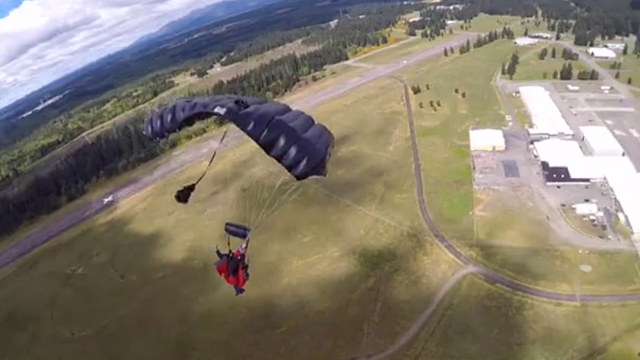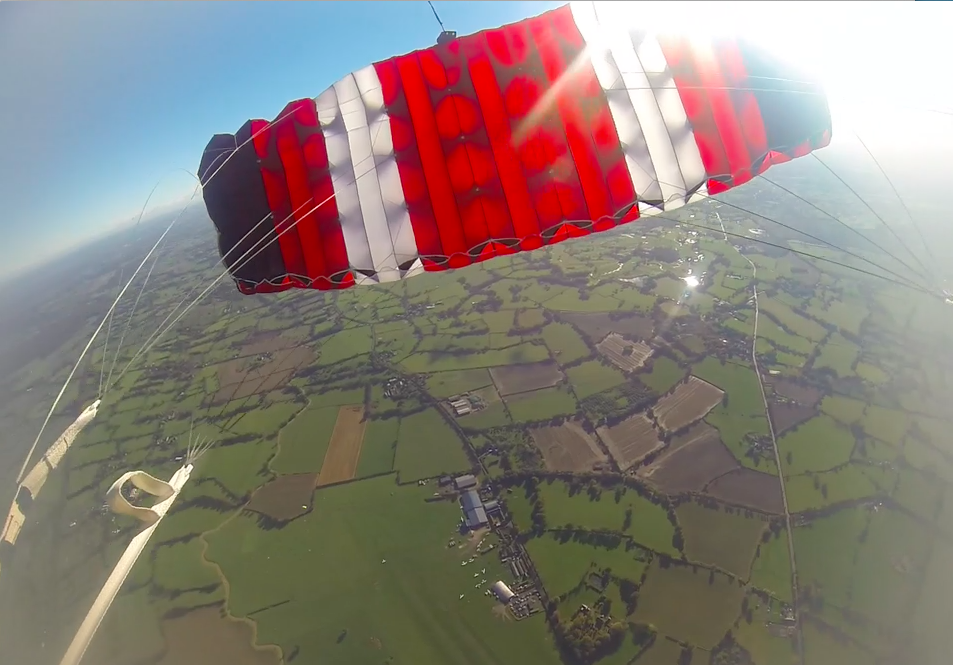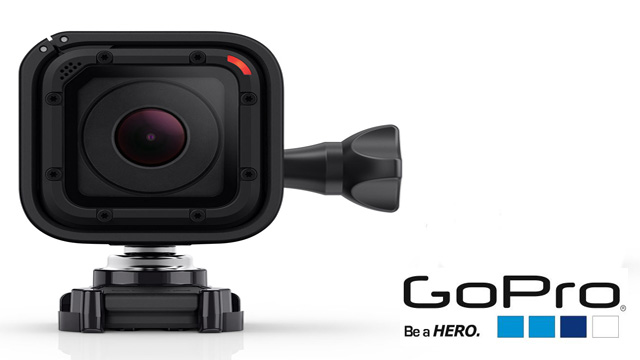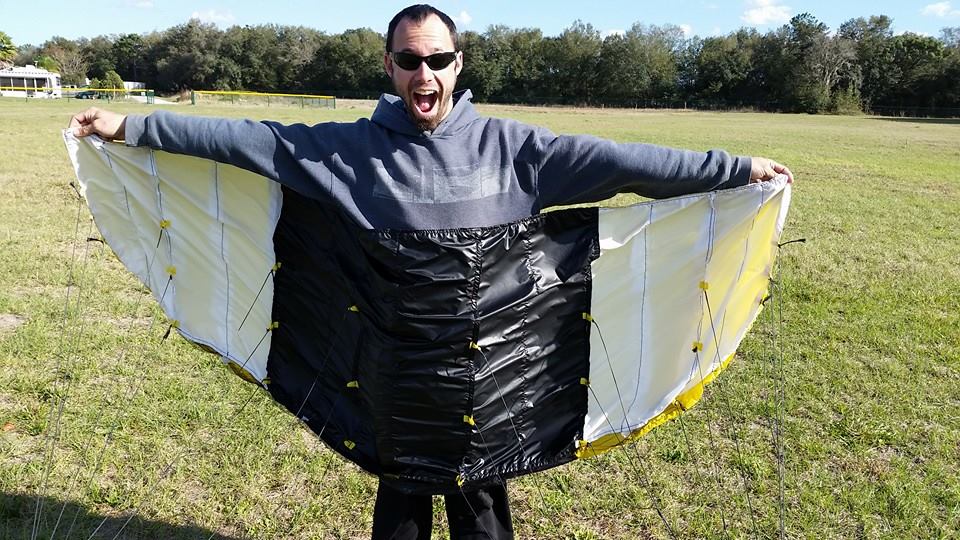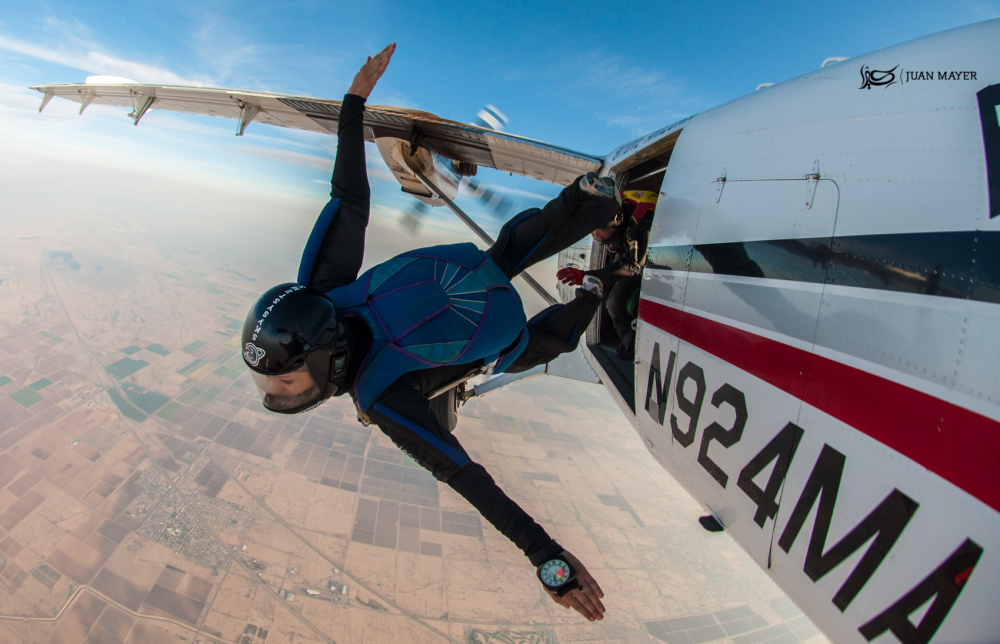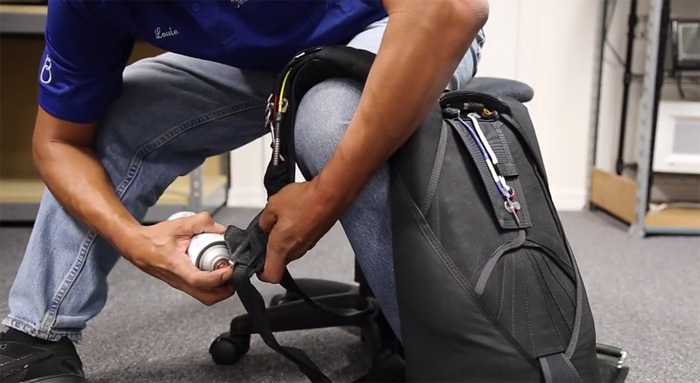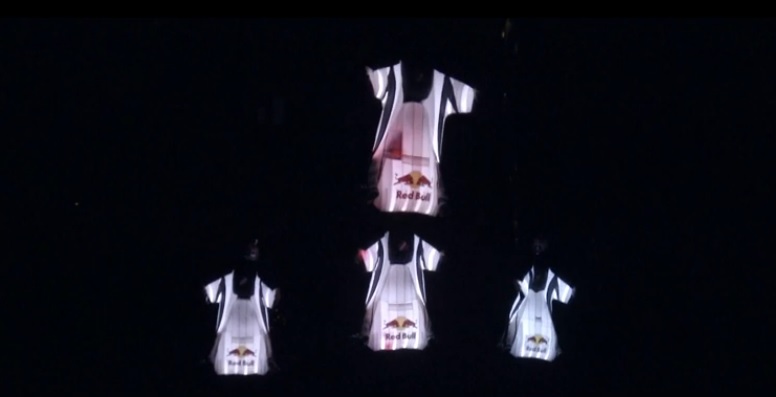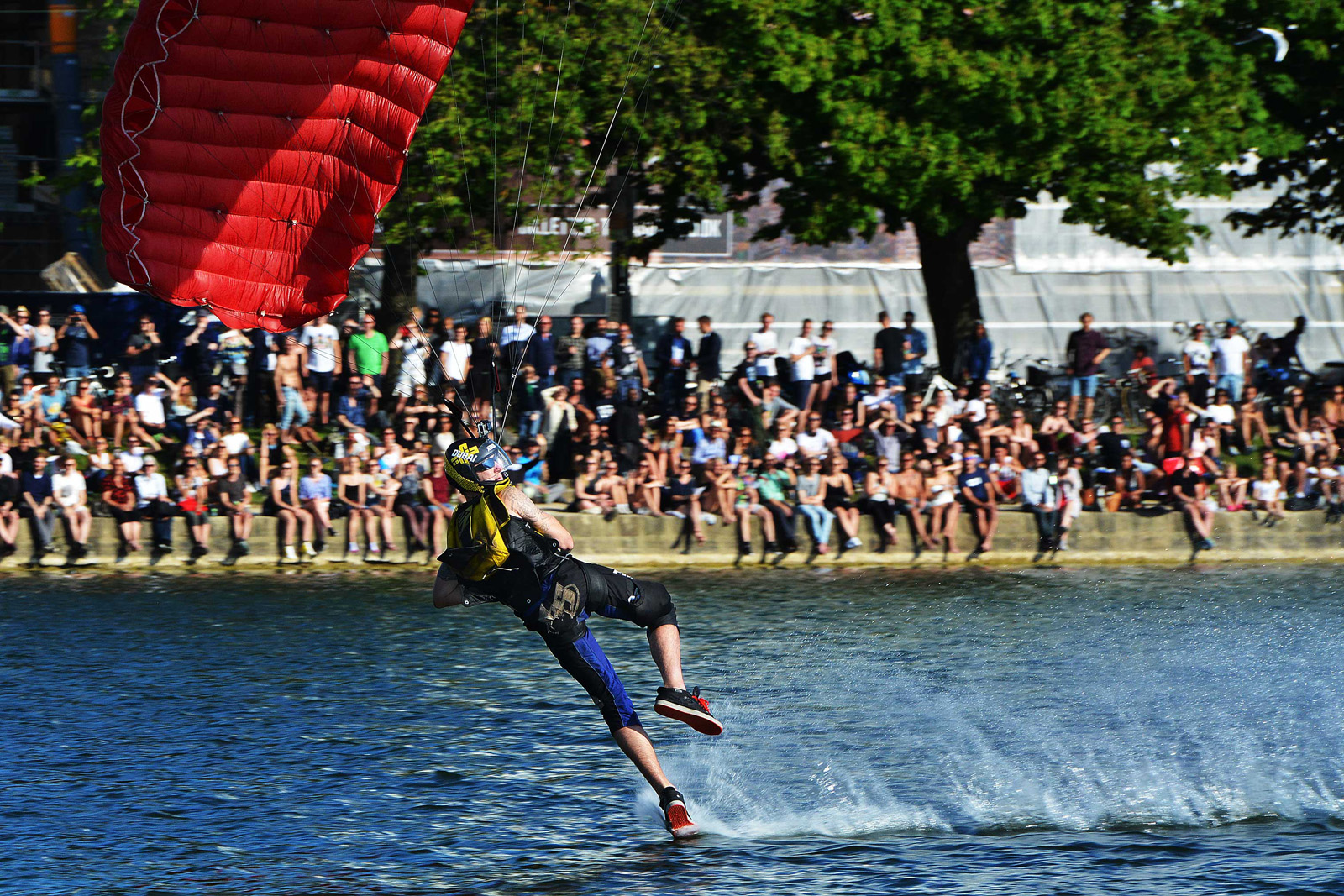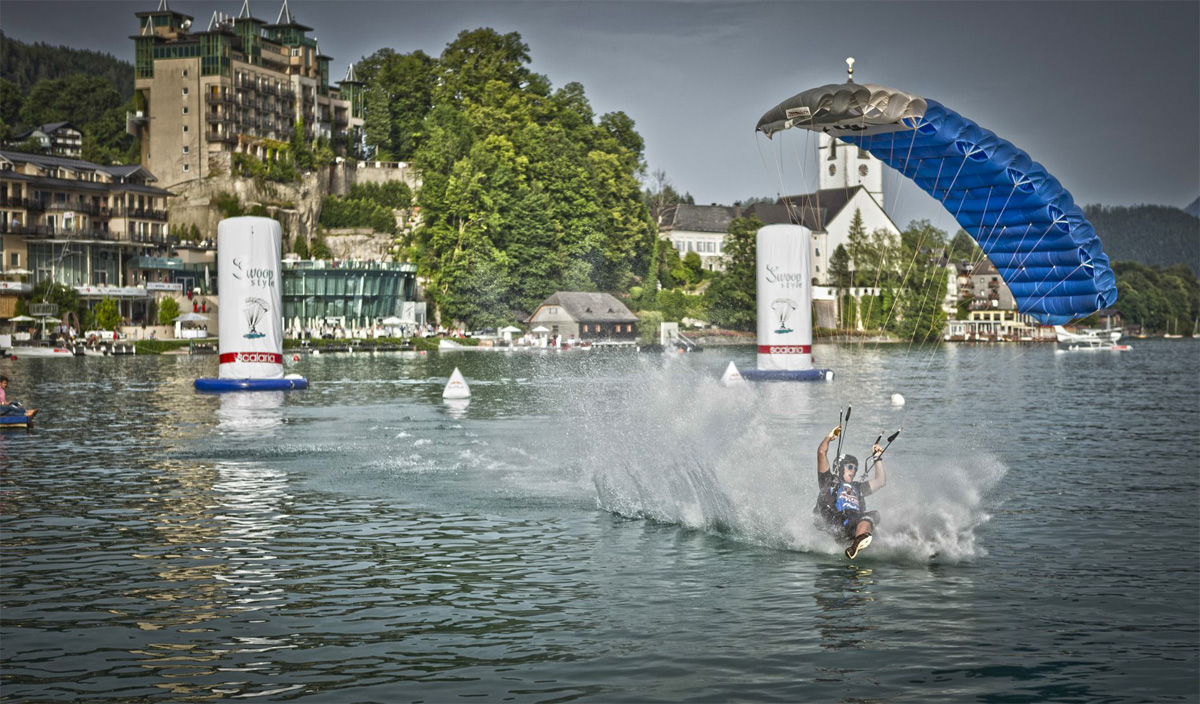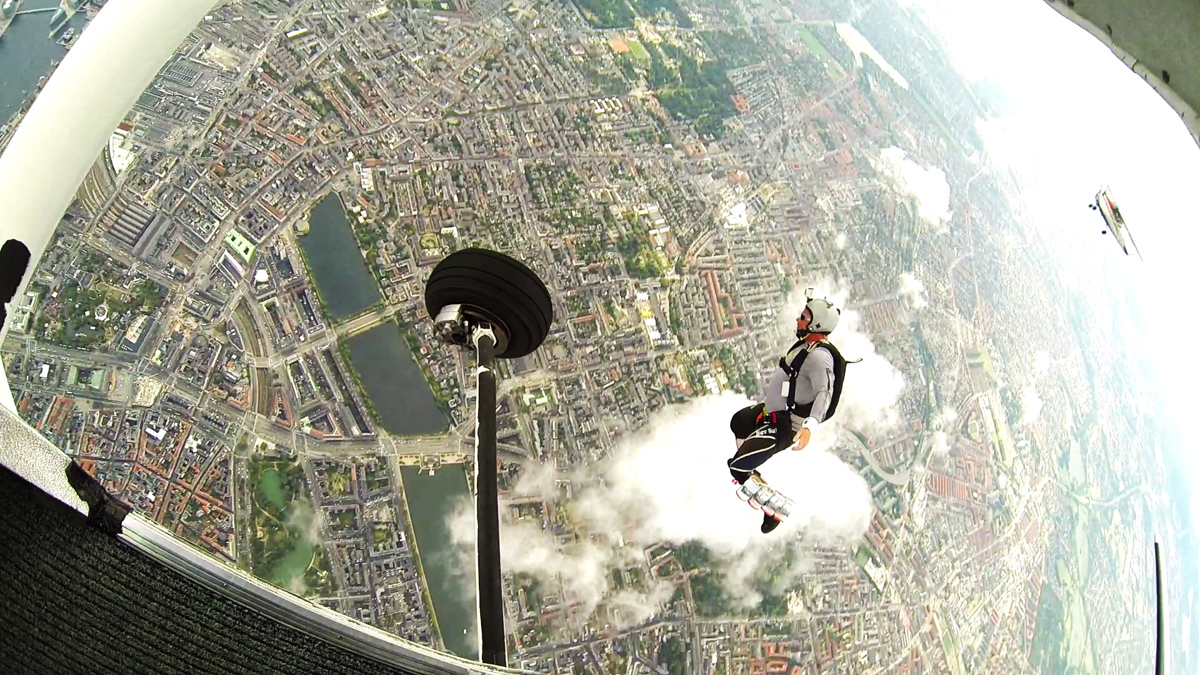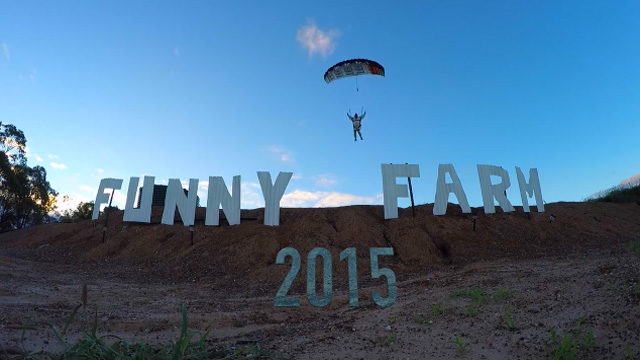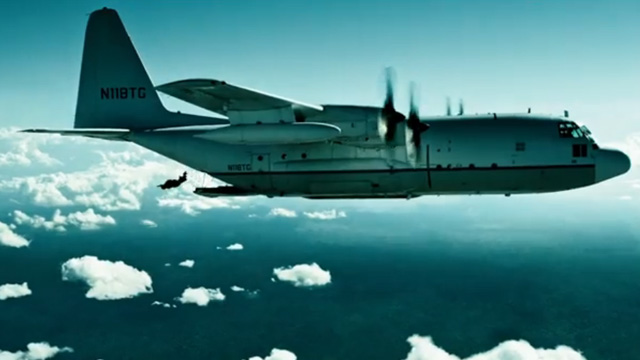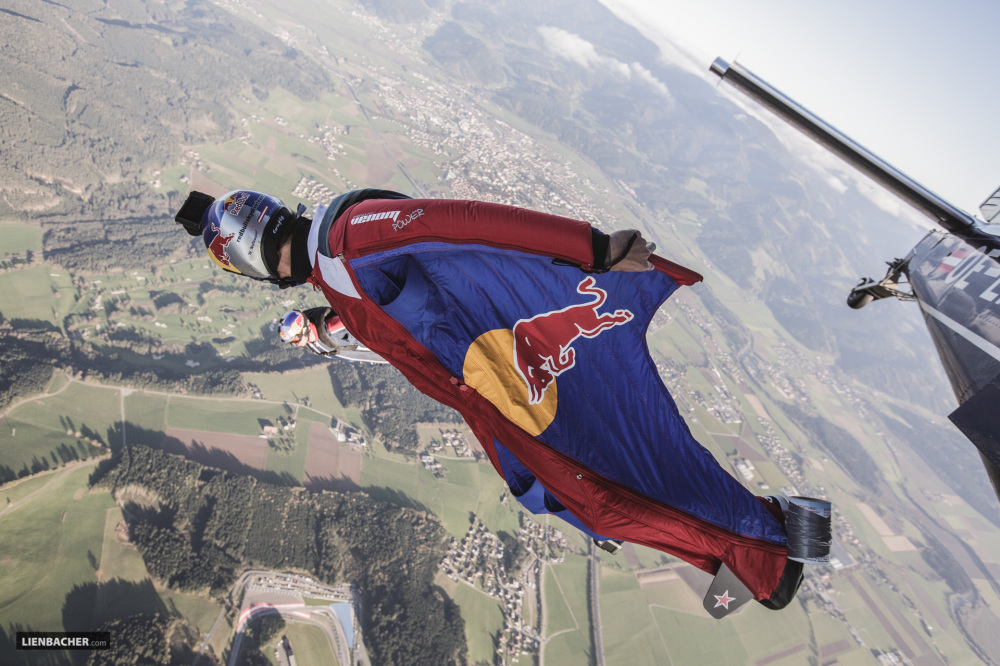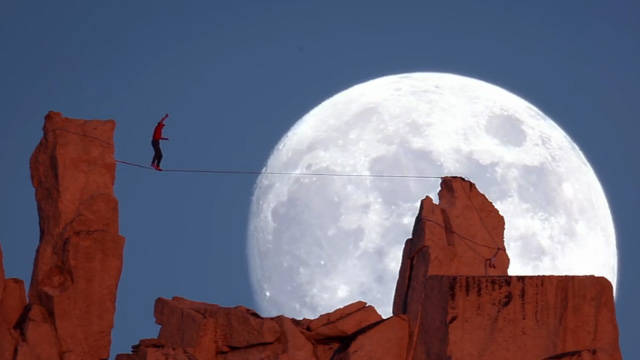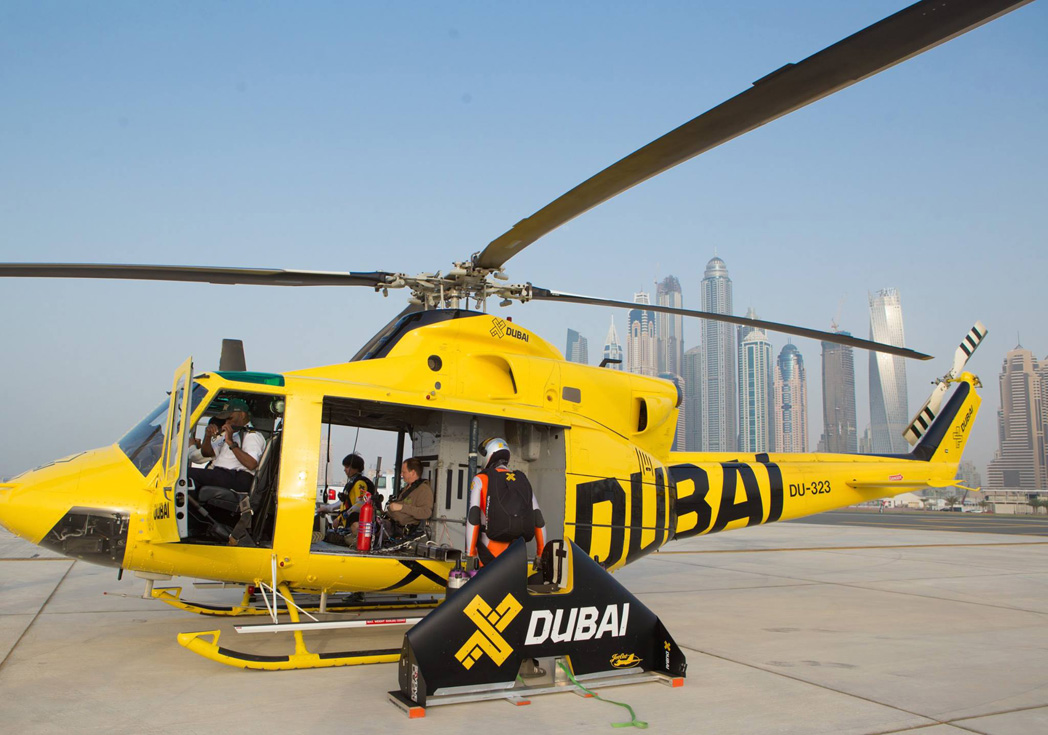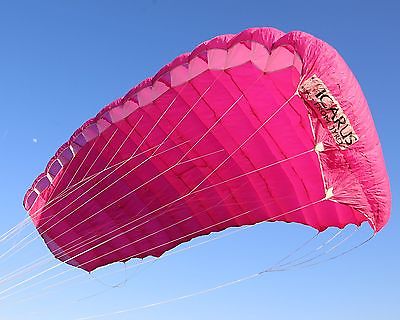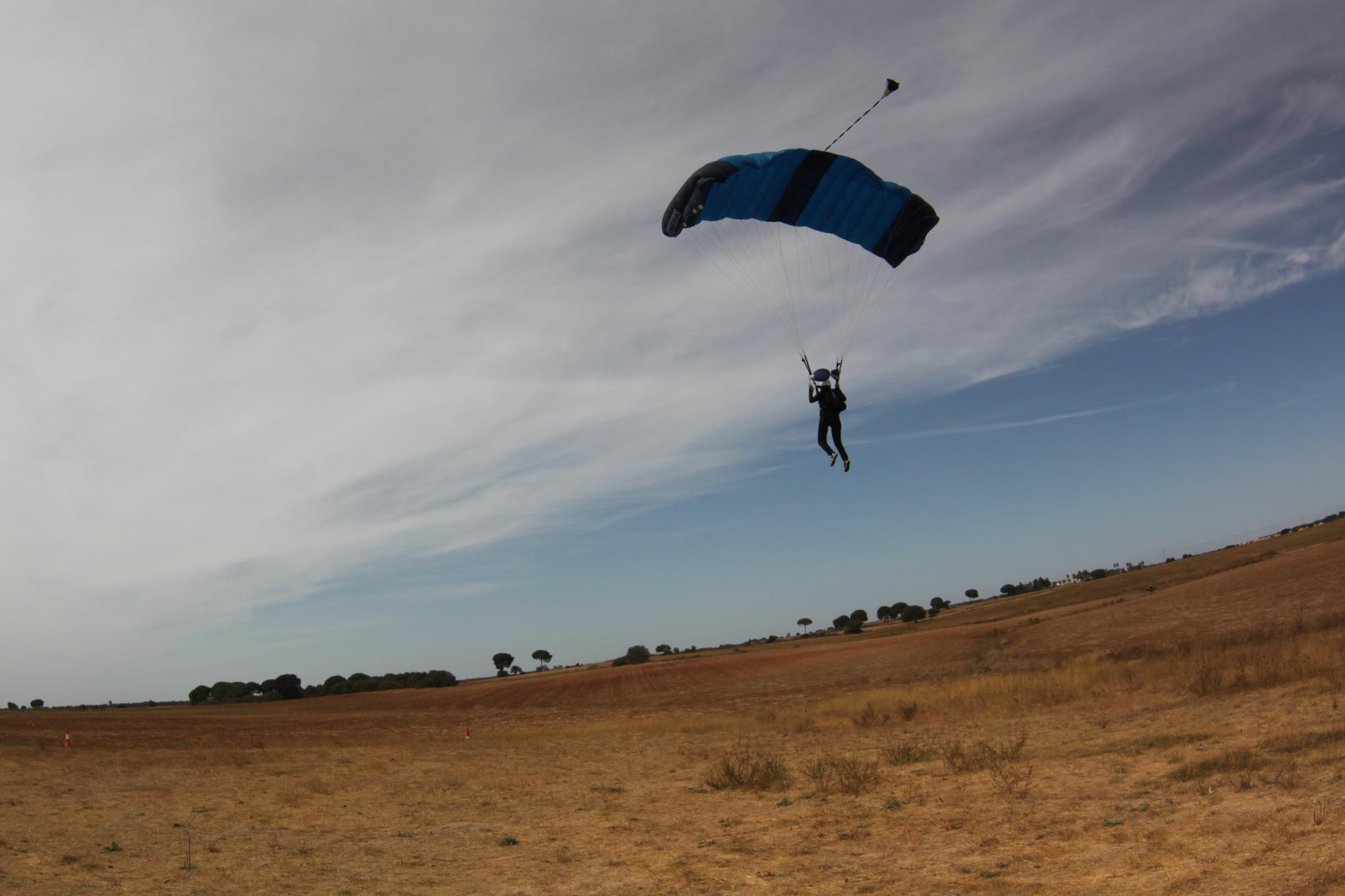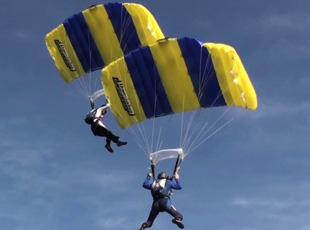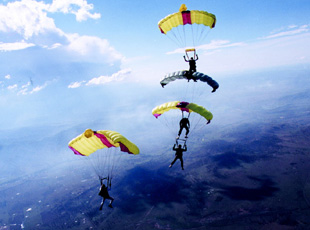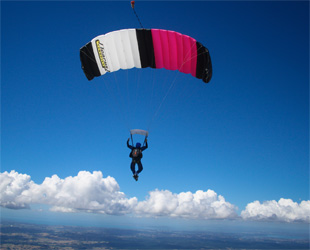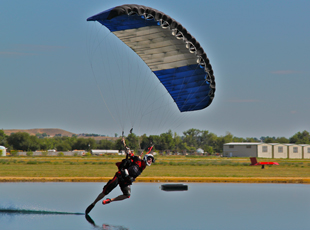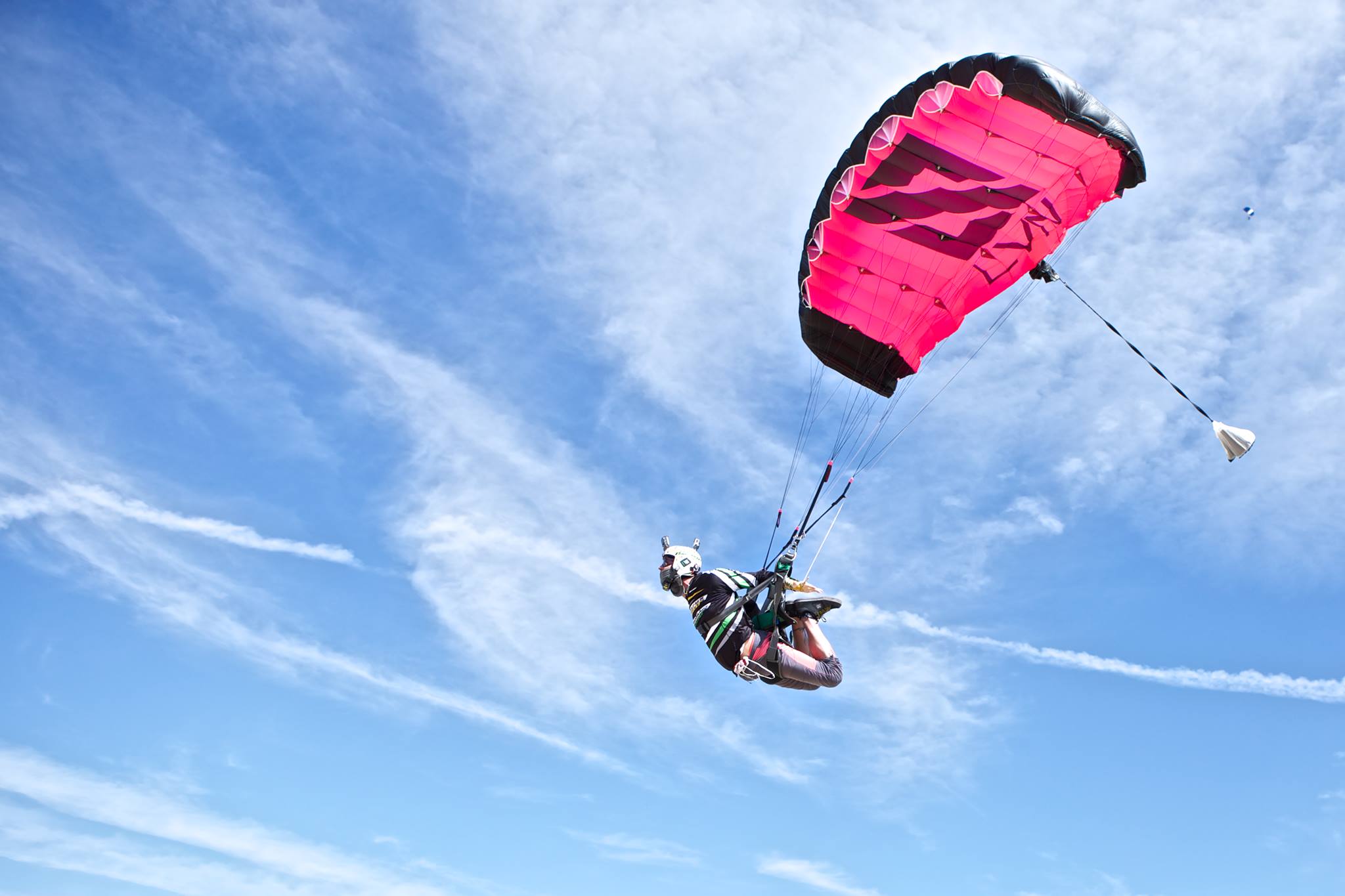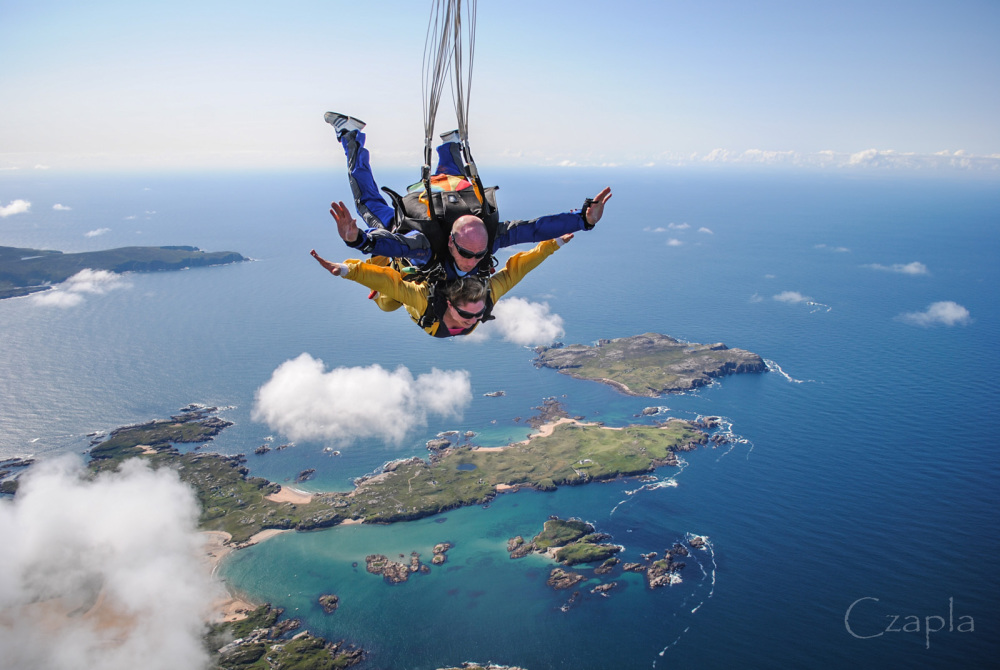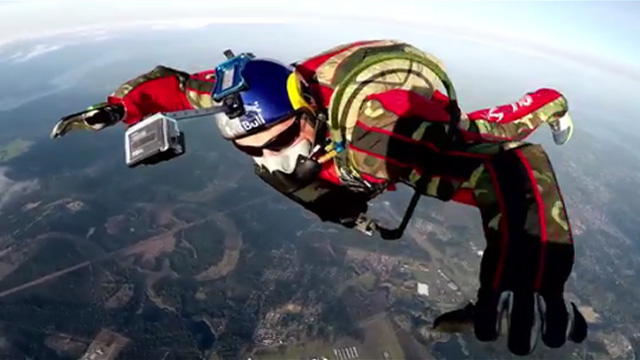-
Content
-14 -
Joined
-
Last visited
-
Days Won
1 -
Feedback
0%
Content Type
Profiles
Forums
Calendar
Dropzones
Gear
Articles
Fatalities
Stolen
Indoor
Help
Downloads
Gallery
Blogs
Store
Videos
Classifieds
Everything posted by admin
-
The guys over at Squirrel have just released a video for their latest canopy, the Epicene. The almost 4-minute long video, which includes a "Rick Roll", also discusses why the Epicene is a great canopy for wingsuit pilots. While Squirrel have historically focused primarily on BASE orientated products, the Epicene is focused towards the skydiving community, though wingsuit flyers in particular. Squirrel have stated that while the Epicene is the best choice for wingsuit flying, it is also perfectly adequate for free flyers as well. The Epicene is built with wingsuit openings in mind and is made in such a way that it reduces the risk for line twists and unpredictability, while at the same time opening quickly and also catering to the responsiveness. The video also puts focus on the pack size of the canopy, with both TJ Landgren and Mike Swanson praising the F-111 hybrid canopy's pack volume. While Squirrel first began releasing information about this canopy mid-2014 it only fairly recently went on sale to the public, and you can find more information on the Squirrel website. Editor's Note: Adjustments were made to this article regarding previously misstated information relating to time of release.
-
Image by TriggerHey, new skydiver! Congratulations. That A-license stamp looks great in the middle of your forehead. Very flattering. Now that you’re in the fold, do yourself a favor: don't dally at the rental counter. It’s an investment (and somewhat counterintuitive) but trust me: you will find it much more cost-effective to buy your first set of gear than to keep renting, but If this is your first set of skydiving gear, you should buy used -- and spend the money you save on jumping. Here’s how to do it right. How to Buy a Used Reserve Parachute Get comfortable with the idea. Picking up a used reserve -- if it’s in spotless shape -- is a smart place to save a lot of cash. Riggers tend to agree that the cost of a brand-new reserve isn’t justified. Choose a damage-free reserve -- no patches, please -- with less than ten rides. Less than five is better. If your reserve is old enough to vote, it’s too old to jump. How to Choose a Used Main Canopy Look for a main with as few jumps on it as you can afford. Newer canopies fly better -- and, importantly, flare better -- than older canopies, because the passing seasons make the fabric more porous. As a rule, you can expect a harder landing from an older canopy. It can be tricky, but your best move is to choose a used main with its original line set. Even honest resellers don’t often know for certain the canopy’s actual jump numbers, and the condition of the line set is an inspecting rigger’s best clue. Find out where your canopy used to live. If it was jumped seasonally at grassy drop zones, it’ll be in much better condition than a year-round desert dropzone. That silicate desert dust chews up the fabric’s protective coating. Beware of beach DZs, too: seawater landings can result in very serious, sneaky damage. Be picky. Do your best to find an undamaged main canopy -- even one that’s been meticulously repaired. These are hard enough to resell that it’s rarely worth the up-front savings. Image by Halldor92572 How to Buy a Used Harness/Container System Do not look for a container first. There are so many reasons why this is the case. You must know the exact sizes of both of your canopies before you can choose a harness/container to fit them. Have a rigger measure your body. Don’t go it alone. Harnesses are sized and carefully proportioned to both height and weight, and you’ll save yourself time by eliminating the guesswork. Ask the seller for the serial number. Then contact the manufacturer with your sizes. Ask the rep whether it’s a good fit for your body and canopies. Impossible to fit? Don’t worry. As you’ve undoubtedly noticed by now, non-standard body types are not uncommon in skydiving. However, new A licenses with unique body types sometimes face an uphill battle. Resizing a harness is almost always an option, but it’s can be so expensive that buying simple, new gear may make more sense. If this is you, research the basic, no-bells-and-whistles container systems available: for instance, the Dolphin, the Genera and the Shadow Racer. How to Buy a Used AAD Be sure that the used AAD meets your basic requirements. Determine that the AAD on offer is within its service life, has met the proper maintenance schedule and is approved for your container system. (Note that both the Cypres II and the Vigil II are waterproof, but the earlier (I) versions are not. Beach/lake dropzone? You know your answer.) Determine your timeline. When you buy an AAD – whether used or new – you’re paying a fixed cost per year. The quality of the AAD doesn’t change over time within its approved lifespan, so don’t worry about snagging a unit within a couple years of expiration. (Just save your pennies while the time runs out.) Buy new, if you can afford it. AADs are very easy to resell. Purchasing a new one is not a bad choice if you have the cash. General Advice for Buying Used Parachuting Equipment Keep an open mind. It’s unlikely that you’ll find a container that matches all the other criteria and comes in your colors. Accept that fact early. Pay a trusted rigger to conduct a pre-purchase inspection on any used gear you buy. The inspection will run you about $25 (or a matching amount of beer). Ask him or her to write down a list of issues – including potential ones – and the cost to remedy them, as if you’re buying a used car. Trust your instincts. If you don't like any potential component of your new skydiving kit — even one that has been suggested to you by a skydiving friend or a rigger or a boogie rep – do not buy it. You'll never be happy with it, and starting out with gear you dislike will adversely affect your entire skydiving career. Love the gear you’re in, and you’ll be a better skydiver for it.
-
GoPro announced the latest addition to their line of action cameras this week with the reveal of the GoPro Hero 4 Session. The Session is small, really small -- about the same size as an ice cube and according to GoPro, it has been in development for several years now. With its reduced size, it will allow for easier mounting, especially for those looking for something to strap to their wrists. Unfortunately, early reports suggest that the decrease in size does not come without a cost. You should not expect the same recording quality, nor the features that are present with the Hero 4 Silver or Black. In their venture to create their smallest action camera yet, GoPro had to make sacrifices on both fronts and you'll only be seeing still images with a maximum resolution of 8 megapixels from the Session. Being less than 1.5 inches in diameter, it goes without saying that you won't be receiving any touch screen or image preview functionality. The cube design features a small LCD screen at the top and just two buttons, the main of which will control all your recording settings and control, while the smaller button is merely a wifi on/off button. Bound to be frustrating to some is that one cannot change between single and burst mode through the camera and requires use of the GoPro app in order to change these settings. There are some positives to mention though, with battery life being one of them. The Hero 4 Session is able to last up to 2 hours while running, better than the battery life seen in the other Hero 4 cameras. Recording AbilitiesWhile one may expect 4k recording from the Hero 4 Session, you're not going to find it. You can however record at a maximum of 30fps at 1440p or 60fps at 1080p. For those looking to get 100fps out of their recording, you will be able to do so at a 720p recording resolution. Overall it is somewhat to be expected, given the size and already clear limitations with the product, however we would have liked to at least see 100fps at 1080p and perhaps 60fps at the 1440p range. The reality is still however, that for the most part 4k recording is overkill and for vast majority of uses 1080p will suffice just fine. Another potentially frustrating aspect to the Session design is because of the cubed shape, some early testers of the camera found that it was easy to hold the wrong way around without noticing. This is likely not going to be a problem for too many people, who will have the device mounted, but for those going handheld, make sure you don't hold it at 90 degrees, or you'll need to do some post-process rotation adjustments. From what we've seen, it appears as though the Session is intended for those looking to create easy and quick HD videos, in the occasional circumstances where the other GoPro models may be too large. Priced at a whopping $400, we are struggling to see too many reasons for the average athlete to opt for the Session over the Hero 4 Silver, which at the same price comes with 4k recording, 4 more megapixels as well as a touch screen. It's Not All Doom and GloomDon't get too caught up in the negative aspects of the Hero 4 Session however, it's still an extremely competent looking camera and while the recording quality may not be the best that GoPro has given us, it's more than enough for your average user who isn't looking for the clearest quality around. It comes standard with 10 meter water proofing, meaning no extra housing needed for most practical uses. The most obvious of the positives however, is the size. Being less than 1.5 inches allows for its use in situations where you may otherwise have struggled. For those who use wrist mounts for their GoPro, the session will definitely serve a purpose. A question that will also obviously come to the minds of many, will be how it compares to the other GoPro series with regards to snag risk. While we haven't been able to see first hand how the Session will handle a snag scenario, there is a lot less surface area so the odds of your lines getting caught seem lower, but the way the mount clamp is positioned in relation to the camera itself, it seems that there remains a risk for snagging between the clamp and the camera. This is something that could be helped a lot by the development of custom mounts, which will no doubt be developed some time after release. If you're currently an owner of a Hero 3 or Hero 4 and shoot regular helmet mounted video footage, we can't see any reason for you to switch out for the Hero 4 Session, but if you're looking for an extra camera for a wrist mount or another area where size is an important factor, the Hero 4 Session may be worth looking into -- if you're willing to fork out the $400.
-
We recently talked with Robert Harris, who took it upon himself to build his own homemade wingsuit. After years of motocross racing, Robert started skydiving five years ago, and since then has attained over 1600 jumps, his D-license as well as AFF and coach ratings. However, what made us want to talk to him, was having seen that he had developed his own DIY wingsuit at home. He talks to us about what inspired him, how he made it and most importantly, how it flew. What made you want to develop this DIY wingsuit? I have always liked knowing how things are made, when I was a kid I took everything apart to try and figure out how it worked and hopefully put it back together before my parents found out. This didn't stop as I got older, although it changed to learning, so I could make things. Shortly after I started wingsuiting I decided I was going to make a wingsuit someday. So last year I asked for a sewing machine for Christmas and didn't get one as no one knew what kind I wanted and I didn't either. I had gotten to use a sewing machine back in middle school home ec class but didn't care about learning sewing, wish they had told me I could make parachutes and wingsuits back then as I would have paid way more attention. After talking to my dz's rigger Sally and some other people and decided to get a singer 20u, after over a month of trying to buy one I found one on Craigslist from an old lady that really never used it for 400$. Then I started sewing. First a pillow case, then a miniature version of my Leia that I made into a traction kite, a belly band, canopy continuity bag, and weight belt. After all of those projects I finally decided it was time to start my wingsuit project. What experience do you have in aeronautics or aviation product development? I don't really have much, but I have started an online class on Aeronautical Engineering to learn more about designing airfoils. I hope to learn to do some equations to determine glide and speed of a given airfoils parameters and hopefully eventually learn CFD(Computational Fluid Dynamics) to push the envelope of what can be done in wingsuits I make later. What were your expectations when starting this project? I was told by quite a few people that I was crazy for wanting to make a wingsuit or that it was too hard and I didn't have a chance. I didn't really care about the designing process when I first started I just wanted to assemble a suit and fly it. I didn't care if it was the best performing suit I just wanted to say I had done it. Although I think I have caught the bug, now I want to make another one and try some new ideas we haven't seen in the wingsuit world yet. Could you explain your creation process to us? When I started I picked one of my wingsuits as a starting platform. I took measurements all over the outside of the suit, and decided to change the arm wings completely as I didn't want to outright copy the suit. I simplified some parts trying to make it out as few as pieces as possible. After all the outside pieces were made came the challenging part of making the ribs. I was originally going to make it with back fly vents so tried to make an airfoil shape that would be as good either on back or belly. I drew out where the ribs would be placed and measured how long they would need to be on the top and bottom skins and as far as thickness goes I knew how wide I wanted the thickest one and the thinnest, to figure out the rest I used some math to taper from the biggest to smallest. After I started sewing I scraped the backfly vents but left the ribs how they where as after putting the fronts on I didn't want to deal with the headache of the backfly ones as well. I spent a couple days making patterns and writing everything down as I did it to make it easier for possibly making another one. After the patterns were all done and checked for fit against each other I started cutting them all out of some parapac I got from JoAnn's fabric with my new hot-knife my girlfriend got me for my birthday. This part went relatively quickly and only took about a day total. Then came the weekend and jumping time, it was hard to pull myself away from my project but I needed to train for the last swoop meet of the season. As weather got crappy I started the sewing. I figured it would be best to get the hardest part done first the arm wings as if I couldn't get those done there was no point in even making the tail. I started with sewing the ribs to front or bottom skin of the suit and quickly learned the sewing the ribs and vents on together was a pain. I did every step on both wings at the same time so I could try and make it as symmetrical as possible and knew they where both put together in the same order. I felt really accomplished when I finished both arm wings and was ready to push through the tail wing quickly before my swoop comp. The tail wing went together pretty easily after making the arm wings and before I knew it I had 3 wings that needed to be put together. After missing a couple of weekdays jumping as I sat busy behind my blue Singer I had finally finished! I was so excited after 23 hours of sewing to go jump it but jumping had already stopped for the day. And how did it fly when you took it out? I really wanted to get some outside video of its (cough cough) first fight. Go figure, none of the normal wingsuiters where around, I eventually asked my friend Paul who has done only a handful or two of wingsuit jumps if he would try. I gave him an I-bird I use for teaching and rig to borrow so he wouldn't be jumping his velo. We talked about the dirt dive and manifested for a load. As we climbed to altitude all I could think about was my family and girlfriend and how dangerous this could be. I did a lot of practice touches of all my handles and went through my emergency procedures as I always do but did way more of them. On the 2 min call we did all the normal handshakes and then I buckled my helmet and zipped up my arm wings. As all the other jumpers were getting off the plane my heart started racing, I used all my yoga experience to get my breathing in check as I walked to the door of the Twin Otter, I could tell Paul was nervous as well. I had him exit before me as I wanted a nice exit shot, as I hopped out from a poised position in the door all I could think was please don't let the suit blow apart! I made sure to keep all my wings shut down on exit and waited to see the tail before I ever so slowly opened my wings. I got my wings open and started flying, I was ecstatic at this point as the suit was staying in one piece. I started my first turn shortly after and was surprised at how stable it was. It took a little bit for Paul and I to get together but around 10k we got together shortly after my practice pull to see if there would be any issues and it was the easiest one I have done in awhile. We flew with each other for a bit and then about 7k I wanted to see what I could do with it. I started a small dive then went in max flight. I decided I would pull higher then normal as I was still jumping my normal wingsuit canopy a Jfx 84 at 4,500 feet. I came in to land with 90 degree turn for nice little swoop. Shortly after Paul landed close by and celebrated an awesome jump! I have never been so excited and nervous on any of my 1600 plus skydives or 4 base jumps yet alone together. After I landed I had to message family and girlfriend to let them know I was ok, they were all pretty scared about me doing it. Since the 1st jump I have only done 1 more on the suit and it was a time run, I got 2 min and 20sconds out of it, which was defiantly shy of the 3-3.5 min I should have gotten out of that size suit. Turns out the fabric I used was my biggest downfall, it didnt have a coating on it like parapac used in other suits so it was constantly bleeding air out and never achieved max pressure. What was the biggest challenge in creating your wingsuit? The biggest challenge by far was trying to figure out what order everything gets put together in, I spent a couple days alone trying to piece it together in my head to figure it out. Although I had to unpick a few parts because of misalignment I did not have to unpick anything because of the order I put it together in. Do you feel that your venture was a success? In the end I feel I achieved my goals I set out for the project and learned tons along the way! I look forward to starting my next suit when I return from visiting my girlfriend in London. I already have tons of things I want to try try and do but the major thing will be a fabric that has zero porosity. About Robert Harris (D-31584): I grew up racing motocross at a early age and after many years of racing I stopped because I was tired of breaking myself. I still rode and one day on the way from riding I got a call about getting to do a free tandem. Of course I said yes much to my parents dismay, they thought skydiving was too dangerous at the time and realize now its more dangerous then motocross. I had loved motocross for the jumps as I loved the feeling of flying through the air. Skydiving was just that pure flying and as soon as I landed I signed up for Aff. One year after I started I had 200 jumps and started wingsuiting on jump 201. My 2nd year in I had my D-license and got interested in Canopy Piloting as well. Since then I have gotten my coach and Aff ratings and am currently on my 5th year of skydiving and have just over 1600 jumps.
-
Image by Juan MayerWhen are you going to be alone in the sky with a useless bag of laundry and two little handles? If it hasn’t happened yet, it’s going to. Sure, there are skydivers with thousands of jumps who have never had to make alternate nylon plans. But don’t be fooled: your first reserve ride is not a question of “if.” It’s a question of “when.” If you don’t feel ready, you’re not alone. Here are ten proven ways to boost your confidence and safety. 1.Stay current Long lapses between jumps are dangerous. Time on the ground dulls skills, sharpens apprehensions and weighs down your jump with the clammy fog of unfamiliarity. Most importantly, it unravels the easy muscle memory you’ve spent so much time and effort to develop -- and muscle memory is of primary importance in the event of a reserve ride. Especially at the beginning of your skydiving career, you’ve got to make the effort to jump at least every couple of weeks. 2. Give ‘er a spin Do yourself a favor and deploy your reserve for every repack. You’ll learn the unique direction of pull for your gear, and you’ll be able to feel out the force you’ll need to exert. If your rigger watches the process, he/she can keep an eye on the deployment and identify potential problems. (Even if you have deployed your own reserve, a repack is an unwasteable drill opportunity for a refresher.) 3. Just touch your stupid handles, Mr. Bigshot, OK? Sheesh Touch your handles in sequence before you enter the plane. It is not beneath you. Being blasé about basic safety doesn’t make you more awesome -- it just makes you more blasé. While you’re at it, check that your reserve handle is seated (so you don’t end up on a reserve ride without the yeehaw fun of a malfunctioning main). 4. Don’t overthink it It’s simple, really. If you believe that your main is unlandable, you’re going to have a reserve ride. Sure -- lots of skydivers have landed under reserves only to realize in hindsight that they could have solved the problem. However, lots of skydivers have gone in while striving to sort out malfunctions that did not improve. If those are the choices, which would you rather be? 5. Get your priorities straight Do not worry about stability. This is the very least of your problems. Worry about altitude. cutaway) handle no lower than 1,000 feet. Initiating a reserve ride below 1,000 feet isn’t always deadly, but it has an unnerving tendency to be. Don’t take the chance. 6. Hold on tight After you pull your handles out completely, hold on to ‘em. You’ll save some money, and you’ll save face when you land. 7. Make sure it’s out This is kinda your last shot at nylon, so you’ll want to be sure it’s working. Arch and look over your shoulder for the reserve pilot chute. Reserves deploy fast, so this head position is gonna butter your bread – but if the pilot chute is somehow caught in your burble, this should either shake it loose or make it clear to you that you need to do some burble intervention, stat. 8. Don’t chase after your ex(-parachute) I’m going to go out on a limb here and tell you not try to run after it and grab it in the air. (People have, y’know, died doing that.) You broke up with each other for a reason, after all; you can reconcile after everybody’s had a little time to cool down. Instead, get your head together and use landmarks to identify where the gear is headed. Then take a deep breath, leave it to the fates, and work on navigating your meat to a safe landing. 9. Tell the peanut gallery to sit and spin When you land a reserve, you’re going to be the talk of the DZ (for about five minutes, usually). During that five minutes – longer, if the loads are turning slowly – you’ll probably be approached by a receiving line of would-be mentors. They’re gonna question your malfunction, and they’re gonna be eager to discuss your decision to cut away. My advice: speak to your trusted mentors and co-jumpers about your little adventure in private, and tell the rest to go suck an egg. You were there. They were not. When you need to save your life in the sky, you are absolutely alone. In the entire world, there exists only you and two handles. Your cutaway is your business. 10. Go to the liquor store Buy a bottle of posh booze for the rigger who packed the reserve you rode. It’s tradition.
-
MANDATORY PRODUCT SERVICE BULLETIN FOR SPECTRA RESERVE RIPCORD REASON: EXCESSIVE URETHANE COATING Spectra Reserve Ripcord Part #: 024 029 001 SPECTRA RIPCORD-24.5" 024 029 002 SPECTRA RIPCORD-26" 024 029 003 SPECTRA RIPCORD-27" 024 029 004 SPECTRA RIPCORD-28" 024 029 005 SPECTRA RIPCORD-29" 024 029 006 SPECTRA RIPCORD-30" 024 029 007 SPECTRA RIPCORD-31" 024 029 008 SPECTRA RIPCORD-23.5" Lot #: UPT-2014-01 UPT-2014-08 UPT-2014-10 UPT-2014-11 UPT-2015-02 UPT-2015-03 UPT-2015-03a UPT-2015-03b UPT-2015-03c UPT-2015-03d LOT # UPT- 2015-04 AND LATER ARE NOT SUBJECT TO THIS PSB BACKGROUND The Spectra Reserve Ripcord system has been in the field now for over 5 years. During that time, it has performed as expected; generating consistently low pull forces because Spectra cord has a very low coefficient of friction. (A similar Spectra main ripcord system has been in use for 15 years on our Sigma Tandem systems). To prevent minor fuzzing and color loss, and to make the finished Spectra reserve ripcord easier to thread through the housing, the finished ripcord is lightly coated with the same polyurethane compound used by Spectra line manufacturers to increase suspension line life. This process increases housing drag slightly but still keeps it below that of stainless cable. It has recently come to our attention that some Spectra ripcord cables manufactured in late 2014 and 2015 were coated with the wrong mix of polyurethane and water, possibly resulting in higher pull forces because of increased housing/ripcord friction. While we believe that this affects only ripcords manufactured from December 2014 to May 2015, we are going to consider all 2014 ripcords suspect. While have been no reported hard pulls in actual use, we will replace all affected ripcord cables free of charge. Because this will take time, we have devised an interim solution that will keep all affected rigs in service until the replacement Spectra ripcord can be installed. PROCEDURE 1. The interim solution must be accomplished before the next jump on the equipment. 2. The replacement ripcord must be installed at the next scheduled repack, no later than December 31, 2015. After this date, all containers with affected spectra ripcords are grounded until the replacement is made. Interim Solution The rig owner, or a parachute rigger, can perform the procedure; the reserve does not need to be opened. It should take no longer than a few minutes. In this video the procedure to complete the interim fix is shown. As noted in the bulletin, these steps are to be taken prior to your next jump and installation of the new spectra ripcord should take place during your next scheduled reserve repack. 1. Put the ripcord side of the harness over your knee 2. Remove the ripcord handle from its pocket 3. Grip the other end of the ripcord just above the pin 4. Applying moderate downward pressure to remove the slack, slide the ripcord back and forth in the housing for 10-15 seconds at 2 cycles per second. Look at the ripcord pin as you perform the procedure to avoid moving it or breaking the seal. This will smooth the excess polyurethane coating thus reducing the pull force 5. AFTER performing step #4, spray a one second burst of pure silicone spray (available at hardware stores) into each end of the housing. This will serve to further lower pull forces. We have not tested any other lubricants, so it is important to use only a “pure” or “food grade” silicone spray because other ingredients might damage the bungee cord inside the ripcord. DO NOT spray the silicone before step #4, as this will make the housing too slippery to smooth the polyurethane 6. Slide the treated ripcord back and forth in the housing under moderate tension 5 times to evenly spread the silicone. Again, be careful not to break the seal Although this procedure will restore normal pull forces, it will require periodic re-lubrication with silicone spray at monthly intervals, and it must be considered a temporary solution, to be used only until you install the replacement ripcord cable. As a reminder use a Sharpie or similar permanent marker, and put a visible dot on the ripcord data sleeve. This will represent the initial treatment performed in June. When you re-lubricate in July, put a second dot on the backside of the data sleeve, a third in August, and so on, until the replacement can be installed. This will allow any jumper to keep track of the monthly lubrication while the interim solution is in effect. Replacement When replacing the Spectra reserve ripcord, the rigger will reuse your existing handle and RSL pin 1. Take a clear photo of the ripcord data sleeve. We need to know your ripcord length. 2. Write down your rig serial number. 3. Go to UPT Vector for more information on requesting a replacement of the Spectra reserve ripcord UPT is working as quickly as possible to build replacement Spectra reserve ripcords, and will get them out as soon as possible. Until you obtain and install your replacement, you may use the current one as long as you follow the directions of the interim solution. If you elect to replace the ripcord cable prior to the due date of your next reserve repack, the rigger who did the original pack job, may be able to install it without opening the container. After resealing the container, the rigger must indicate this PSB has been complied with on the packing data card. The original (next) repack date remains the same as it was before ripcord replacement. DISCUSSION In the US, maximum allowable pull force is 22 pounds (10 Kilograms) with the rigger’s seal in place. This force, measured at the ripcord handle, is a combination of the force required to move the pin, the housing friction, and the force required to break the seal thread. The standard does not specify how this is to be measured, but there are basically only two ways, which could be called “Static” or “Dynamic”. The static force is measured by pulling the ripcord handle very slowly while it is attached to a hand held spring (fish) scale. To measure the dynamic force, where a ripcord is pulled quickly, as in real life, requires a digital scale with the correct sampling rate and peak force recording ability. Our tests using such equipment show that dynamic pull force is often less than half of the static pull force. This research confirms an important fact of which all jumpers should be aware: A quick "jerk" on the handle will give a much easier pull than will a slow steady application of force.
-
Regardless of how you feel about the sponsor giant, Redbull have continued to show what a large budget can do in terms of both stunt orchestration and production quality of video footage. One of Redbull's latest productions, titled GRAVITAS, puts together the ingredients of wingsuit pilots, drum and bass and LED lights to create some stunning skydiving eye candy. According to Redbull.com, the pilots, Marco Waltenspiel, Georg Lettner, David Hasenschwandtner and Dominic Roithmair exited at 13 000 feet with LED lit wingsuits. Once in flight they began their choreographed maneuvers to the music of Camo & Krooked. Other companies involved in the project include Paranormal Unicorn and Frame Fatale.
-
The best skydivers in the world had an epic day in Copenhagen taking part in the first professional freestyle skydiving contest ever held in the heart of a major city. The Swoop Challenge CPH Invitational, took place on the famous Copenhagen Lakes, Friday the 12th June. A total of 19 international athletes from 11 countries participated, 16 of them making it to the final in Copenhagen. 70,000+ spectators created an intense atmosphere at the Peblinge Lake, whilst the live broadcast on national TV , and 200 million reached on Snapchat's 'Copenhagen Story' helped in making the event a huge success, as the city took advantage of the first Danish summer day basking in the sun and warm temperatures throughout the whole event. The Swoop Finals were the culmination of 5 days of intense parachuting in Denmark as the Swoop Challenge consisted of a Swoop Qualifying at Dropzone Denmark in Herning, the Swoop Night Lights, a spectacular air show in the Copenhagen Harbour on Thursday, and the the climax, The Swoop Finals on Friday. American superstars led the wayThe sunny and warm weather made conditions close to perfect for the spectator, however the wind direction and strength was unpredictable causing problems for the athletes during the warm up and two competition rounds, with many ending up in the water next to the landing platform (6 meters wide/25 meters long). At the end of a dramatic and close two rounds of competition, it was American superstar Noah Bahnson, one of the top names of the sport, that took home the Swoop Challenge title along with a first price of $7,500. In a close second came Nick Batsch, USA, ($5,000) (both are former swoop world champions) and David 'Junior' Ludvik, USA, ($2,500) rounded up the podium in 3rd. "I have never swooped in front of this many people before and it's just amazing in this beautiful weather and on a great course here in the middle of Copenhagen. We normally don't get to see this setup in skydiving because swooping competitions are held out on skydiving centers in the middle of nowhere on a small pond, so it's fantastic what the organizers are doing bringing the competition to a major city for the first time. Copenhagen is an amazing city from the sky and it is beautiful so see the city from above and landing on the big lake. We have all had a great stay in Denmark attending this fantastic Swoop Challenge event," the winner Noah Bahnson says and adds: "My last swoop is up there among my favorite swoops of all time, it was too much fun," Noah Bahson said on live TV while watching his swoop freestyle trick after he was announced as the winner. World premiere of a difficult and dangerous trick Another American, Gage Galle, attempted something that has only been attempted once, and never been caught on camera before: The barrel roll swoop, a very difficult inverted manouver, best performed over water, due to the high probability of a crash. Even though this trick has never been successfully completed, Gage chose live TV to make his attempt. He succeeded with the barrel roll, and despite crashing in the water exiting the trick, the judges gave him a high score, and for the first time ever, a barrel roll was caught on camera with the crowds going crazy. The world tour dream is aliveThe idea of Swoop Challenge and the motto 'Swoop to the People' was only formed in 2013, and after a trial event last year, the big test of the setup was Friday's competition. Next step is taking the concept to other major, spectacular cities around the world: "What a fantastic day. The 70,000+ spectators in Copenhagen had a giant party, and the crowd created a unique atmosphere around the lake. We have been working extremely hard to build this event over the past two years, and it all became a little more complicated due to the weather forecasts, that made us reschedule on short notice, but despite that, Swoop Challenge was a great success and we are thrilled and proud. 70,000 people chose to stop by the lake today, and this makes it clear to us, that it is possible to unite the beauty in extreme sports and the heart of a historical, cultural metropolitan. After today's success we are dedicated to carry Swoop Challenge across the borders and create a world tour, but it is only attainable, if others are willing to support us. Our athletes, whom are the among the best swoopers in the world, have all said, that it was amazing to jump in Copenhagen," says George Blythe, co-founder of Swoop Challenge. "Swoop Challenge was organized with great success. It opened our eyes and gave us world class parachuters in the skies above Herning and Copenhagen. With this great event, Swoop Challenge has achieved to take event planning the to the next level, and shows us a new way to use spectacular arenas for sporting events. The international athletes tells us, that they have never experienced a more beautiful place to skydive than Copenhagen, and it proves, that the concept of Swoop Challenge is on the right track," says Lars Lundov, CEO of Sport Event Denmark, the national sporting event organization that works to attract major international sporting events to Denmark and that supports Swoop Challenge financially. Dane Webber close to a sensational podiumThe only competitor from Denmark, the Danish swoop champion, Christian Webber, had a great day on home ground, and was sitting at a sensational 2nd place after the first round, after super star Micah Couch, USA. The Dane, who is employed full time and only jumps in weekends and 7 weeks a year on training camps was by far the one with fewest career jumps at 2,800. The Dane followed up with a solid second round to take home an impressive 6th place finish on home ground to the delight of himself and the Danish spectators. Top-6 - the total number of point attainable were 100 per round (200 total after 2 rounds) 1: Noah Bahnson, USA - 140,80 points (60,60 and 80,20) 2: Nick Batsch, USA - 140,01 points (58,32 and 81,69) 3: David Junior Ludvik, USA - 133,49 points (58,75 and 74,74) 4: Patrick Kaye, USA - 126,28 points (57,00 and 69,28) 5: Curt Bartholomew, USA - 123,53 points (57,68 and 65,85) 6: Christian Webber, Denmark - 112,32 points (63,76 and 48,56) ----- 7: Cornelia Mihai, Romania 8: Billy Sharman, South Africa 9: Gage Galle, USA 10: Petter Mazzetta, Sweden 11: Abdulbari Qubaisi, UAE 12: Martin Reynolds, England 13: Micah Couch, USA 14: Chris Stewart, New Zealand 15: Leigh ‘Macca’ McCormack, Australia 16: Kristian Moxnes, Norway Tukes Iwamoto from Japan, Kenneth Gajda from Denmark and Jeannie Bartholomew from America were the three athletes not qualifying for Swoop Finals, but they each had a chance to perform at the Swoop Night Lights on Thursday evening in the Copenhagen Harbour.
-
Falling from 1,500 meters at speeds in excess of 130 kilometers per hour, this years “Swoop Style” competitors will yet again risk their lives to take home the prestigious title. This relatively new sport, only made possible through recent advancements in parachute technology, has become one of the most highly anticipated events at the Scalaria Air Challenge each year because of the extreme skill and bravery needed to participate. Competition is fierce as participants jump from a helicopter 1,500 meters above the ‘seepromenade’ and soar down through obstacle courses at dangerously high speeds in hopes of landing on a small platform on the water. Speed, line and accuracy are the ingredients for success. “Swoop Style Masters” will take place for the third time this July at the 10th anniversary edition of the Scalaria Air Challenge in St. Wolfgang im Salzkammergut, Austria. Top athletes from around the glove including Bill Sharman, Patrick Kaye, Julien Guilho and the Red Bull Skydive Team (with over 10,000 jumps will descend upon the Air Challenge in order to make history for their sport. However, Swoop Style Masters is not the only event at the Scalaria Air Challenge that will shock and awe. Constantly pushing the limits of what is possible, it is an event that originally began as a small gathering of seaplanes on the beautiful Lake Wolfgang and has turned into an internationally recognized spectacle in the air, on the water and at the resort. This year, the event will celebrate 10 Years of outstanding performances, celebrity appearances, and inspiring exhibitions, with over 30 flying guests including: Dornier DO-24 – the only seaplane of its type Lockheed Super Constellation Red Bull’s Flying Bulls – the whole family Baltic Bees – 6 jet formation Red Bull Air Race World Champion Hannes Arch & Pete McLeod Felix Baumgartner | Red Bull Stratos Jump Hero Blacky Schwarz – Red Bull Cobra Pilot & Helicopter World Champion About scalaria – the event resort: Nestled in the Alps, scalaria event resort is an ideal destination for meetings, presentations, conventions, ceremonies and banquets. The resort leaves nothing to the imagination, offering 4 unique event facilities, 20 meeting rooms, 400 beds in impeccably styled rooms and 360- degree views of the Salzkammergut and Lake Wolfgang. The elegant blend of traditional and contemporary styles are an attraction to international brands, such as Red Bull, Nike and Aston Martin. For more information, please go to www.scalaria.com.
-
The centre of Copenhagen will become the stage for a world premiere on Saturday June 13th. The famous Copenhagen Lakes in the middle of Denmark's capital will host the first ever professional freestyle parachuting competition ever organized in the heart of a major city as the Swoop Challenge CPH Invitational gathers the world's top athletes for 6 days of intense parachuting in a unique format. The philosophy of Swoop Challenge is to take parachuting to the people. The action packed and intense parachuting meets the urban and cultural settings of a vibrant big city in a unique blend of culture and extreme sports in beautiful settings in Denmark's capital. The best athlete after the two rounds will be crowned Swoop Challenge CPH Invitational 2015 champion and will receive a USD 7,500 first prize. Second and third place finishers will receive $5,000 and $2,500 respectively. Innovation of the sportThe Swoop Challenge CPH Invitational 2015 consists of six days of parachuting: A training camp and qualification, a grand air show in the Copenhagen Harbour and the competition day on the Copenhagen Lakes with more than 50,000 spectators watching. The professionalisation of the sport, the brand new competition format and the idea of having parachuting in urban areas has never been seen anywhere in the world. “We’re turning everything upside down and bringing extreme sport into the hearts of cities where people can experience it right in front of their own doors rather than out in the middle of nowhere where it usually takes place. We like playing with the contrast of extreme sports within a cultural and historic city while really focusing on the live experience for both spectators and viewers alike," co-founder George Blythe says. Image by Anders Bruun LarsenIn 2013 he and co-founder Michael Kattrup Lassen came up with the idea to parachute in the middle of major cities, where people naturally are. In August last year with the help from a lot of friends they showcased the sport and had 14 athletes doing one display jump each to test what was possible. The outcome by far exceeded the expectations of the duo and they partnered up with other experienced persons in the parachuting and event world to pull off the next step of their plan: The first professional freestyle competition ever to be held in the center of major cities. "We know from last years pilot project, where we held a display with 14 jumpers, that parachuting in the heart of cities was very interesting. Back then we had no idea what was going to happen, but 20,000 spectators turned up at Peblinge Lake with both national tv stations, DR and TV 2, covering the event. This success gave us the drive to follow our dream of developing a full-blown competition in the middle of cities where the world’s best athletes would be brought to town. We now have some the world’s best that are very excited about the idea of Copenhagen and we’re really looking forward to presenting them to the thousands of spectators at Peblinge Lake Saturday June 13," George Blythe says. Best extreme sports athletes in the worldAthletes from 11 countries are coming to Denmark and among the are multiple world champions and top athletes of the sport. They visit Herning and Copenhagen to take part in a competition of the highest international level and in a format none of them have seen before. Image by Aleksander Horup"One of my favorite disciplines in swooping is freestyle, and I love being able to swoop in very unique places. The opportunity to swoop in downtown Copenhagen in front of more than 50,000 spectators is awesome and something like this has never happened before. Swooping in a major city is a big dream and I am glad to be a part of such an amazing event," says American Curt Bartholomew, the defending swoop world champion from 2014 and 2012 and the 2013 World Games and World Cup champion. The 20 athletes will be attending a training camp and qualifying in Herning at Dropzone Denmark where they will compete for one of the 16 spots in the Swoop Finals in Copenhagen. Athletes from 13 countries are competing: Abdulbari Qubeisi, United Arab Emirates, 4,600 jumps Billy Sharman, South Africa, 8,642 jumps Chris Stewart, New Zealand, 5,100 jumps Christian Webber, Denmark, 2,800 jumps Cornelia Mihai, Romania, 7,000 jumps Curt Bartholomew, USA, 6,900 jumps David 'Junior' Ludvik, USA, 14,500 jumps Gage Galle, USA, 8,000 jumps Jeannie Bartholomew, USA, 3,000 jumps Kenneth Gajda, Denmark, 11,000+ jumps Kristian Moxnes, Norway, 8,000 jumps Leigh McCormack, Australia, 4,830 jumps Martin Reynolds, England, 5,500 jumps Micah Couch, USA, 10,000 jumps Nicholas Batsch, USA, 7,250 jumps Noah Bahnson, USA, 10,000+ jumps Patrick Kaye, USA, 15,000 jumps Petter Mazzetta, Sweden, 7,500 jumps Tukes Iwamoto, Japan, 10,000 jumps Support from official DenmarkBoth the City of Copenhagen and Sport Event Denmark are supporting the event and look forward to see this brand new initiative: "This is the first time a professional freestyle parachuting event takes place in the heart of a major city, and Copenhagen is the perfect venue with the lakes as the iconic backdrop. The setup is creative and unique in a way we haven't seen before and it correlates perfect with Copenhagen's image as a both historic and cultural capital and an urban and innovative city. When it comes to Swoop Challenge, Copenhagen shows that this is a city that loves sports events in the heart of the city," says Carl Christian Ebbesen, Mayor of Culture and Leisure in the City of Copenhagen. The city supports Swoop Challenge financially. "In Denmark we organize a wide range of international sporting events on land and water, and with Swoop Challenge now also from the air over Herning and Copenhagen. The Swoop Finals in Copenhagen will be the first, professional freestyle parachuting competition ever held in the heart of a major city, and Copenhagen will once again be showcased as an event destination of the highest international standard," says Lars Lundov, CEO of Sport Event Denmark, the national sporting event organization that works to attract major international sport events to Denmark and who supports Swoop Challenge financially. PROGRAM FOR SIX DAYS OF INTENSE PARACHUTING June 8-13 2015:Swoop Qualifying Monday to Wednesday June 8th to 10th, Dropzone Denmark, Herning: Training camp Monday and Tuesday and qualification Wednesday for 20 athletes. The top-16 in the qualifying rounds will attend the Swoop Finals in Copenhagen. Swoop Night Lights Friday June 12th, Nordre Toldbod, Copenhagen Harbour: Spectacular airshow over Copenhagen in front of Toldboden and CPH City & Port Development's headquarters. From 18.00-20.00 (6-8pm). Swoop Finals Saturday, June 13th, Peblinge Lake Two rounds of competition at Peblinge Lake in front of Kaffesalonen’s platform, where the total score after two rounds decides the winner of the Swoop Challenge title. From 13.00-18.00 (1-6pm) For The Whuffos - How Swooping WorksThe participants jump out of helicopters in 1.500 meters/5000f and deploy their parachutes shortly after, as the focus is on the actual flight in the parachute, not the free fall aspect. The small and aggressive parachutes, called canopies, enable the athletes to fly fast towards the ground. When arriving above the course, the swooper dives the canopy towards the lake's surface to reach speeds of almost 150km/h and prior to contacting the water the swooper levels out the flight. The last stage of swooping consists of freestyle tricks on the water with high speeds before landing on a platform right in front of the spectators. 22 tricks currently exist and can be combined into different combos. There will be two rounds and five international judges will score each jump based on the turn towards the water, the actual freestyle swoop and the landing.
-
You know that one time of the year where you are forced to go home and spend time with your family and you have to do it but don’t really want to? Yeah funny farm is nothing like that. At all! Mid April, 120 excited farmers travelled from all over the world on the yearly pilgrimage to a cattle farm near Westmar, Queensland, for a week of kick ass jumping and a lifetime of fond memories. The coach line up this time consisted of return farmers, Domi, Mox, Anna, Reader, Dougs, Jeff, Boagsy, Munting, Blakey and Macca. New recruits Luis Prinetto and Jason Petters joined the Farmily this year too. For the first time farmers it can be a daunting boogie, as its 6hrs from Brisbane, no flushing toilets, no reception and the nearest pub/store is 30mins drive away. But those who dare to brave it are richly rewarded. Mad Skills From All Around The WorldThis year differed from previous years. It was open invite and the concept of this year’s farm was to not only keep improving the level of flying, but to also incorporate multiple disciplines in each jump. At the start of the week it was kept simple and easy, combining only two types at the same time. Woody and Griggsy helped skill up the XRW crew and the Dubai wingsuiters added another layer of innovation as people got their skills and confidence up the complexity of what was being attempted increased. By the end of the week it became important to get to the emplaning area early because it was a creative process to work out exit orders because the normal assumptions about exit order did not apply. Some old farmers returned which added the special vibe that is Funny Farm. Douggs was in charge of everything comical, so that the hot shots didn’t take themselves too seriously (which becomes challenging when Elad is slow mo-ing every rad manoeuvre and bathing you in day tape glory). Swoop comps involved directives like the running man, the turtle and some other crazy names which were always accompanied by laughter and an animated explanation of how they were to be performed, including historical information of who won these comp categories in farms gone by. After a recommendation from Robbie that only already competent swoopers participate, this advice was ignored by Spready who though he would give it a go anyway, not successfully. The comps were embraced by the mega swoopers who added entertainment to their exceptional skill and created a daily gathering at the pond to watch the triumph and failure. Luke Scab was a key leader in the commitment to running the pond every jump and quickly ran out of dry shoes but was a crowd favourite and didn’t need the services of Kenny the Gold Coast lifesaver who was on standby. No Shortage of VarietyThe day tapes were epic and long trying to keep up with all the new and cool things that were being done by so many groups each day. There were wingsuiters chasing the Yak. XRW with wingsuiters, canopies and planes. Full loads of Static mixed formations being carved around by a plane loads of movement flyers. Heaps of wingsuiters and freeflyers tearing it up in every orientation. Douggs’ ‘barely moving forward jumps’, Ariel silks from a tandem with canopies, and much much more. The United Nations could take a leaf out of our book for bridging the cultural divide. Just watch the video its MEGA! With the exception of Spready’s inspection of the bottom of the pond and Jeff’s in-flight seminar on drag differentiation. Everyone was safe during the week which keeps the event in good spirits and stops Robbie from increasing his angle as he stomps across the landing area towards the jumper who has made a questionable safety choice. You know if you are getting out the protractor as he approaches and it is anywhere from the 80-45 degree angle you need to start making excuses fast. The Convery brothers are always manage to rile up Robbie and Irish continued to stir up Robbie after hours with his MC gig, must be something about the Irish Ranga combo that causes fireworks and entertainment to the crowd. Ready was the hero of party night for epic vision that at first glance appeared to be a dead tree. Which he erected in the landing area and set it alight, a leaf blower turned into a flame thrower as they pumped oxygen into the burning 3m log. With the regular camp fire covered in cooper flakes burning green, the flaming tree spewing heat and light into the sky, some flares being thrown around and the flashing lights on the drone flying overhead, was visually spectacular and was quite an experience for everyone with a bit on. Funny Farm is hard to describe accurately, just trust me when I say if you ever get the chance to come, make it happen. This is one event that for sure couldn’t happen without endless support from sponsors the Australian Parachuting Council, South Queensland Parachuting Council, Cookie, Downward Trend Rigging, LVN lifestyle and NZ Aerosports and the Mulckey Family who allow their normally tranquil farm to be turned into our playground for one week a year. Stats from the Week2992 slots, 225 loads, 14500 litres of fuel, 224 Cartons of beer, 120 Jumpers, Two Caravans, One 182 and a YAK 52. Heaps of Kouta, Feckin Bewm. Who’s Hungry and gooood could be heard too. And Major Lazer ‘Lean on’ played approximately 45 times. *** Disclaimer: some of these stats might not be entirely accurate*****
-
For those skydivers old enough to remember the early 90s, they will also surely recall the movie Point Break. Released in 1991, Point Break was centered around a group of surfers who robbed banks while wearing masks of ex-presidents. An undercover agent, Johnny Utah, was sent in to the world of the 'ex-presidents' as they called themselves, to gather information. Johnny Utah however, finds himself forming a bond with those he is trying to help apprehend. Despite the scenes of surfing and action, the movie has been best known for the skydiving scenes, which while certainly not the best, were some of the most memorable to viewers. It was clear that story and script were never high on the priority list, and the film focused almost entirely on the action sequences, of which there were quite a few. Point Break was the kind of movie you either bragged to your friends about loving, or the guilty pleasure movie that you kept in an unlabelled VHS container and only watched once the kids and wife were asleep. Well, good news for fans of the original movie is that the ex-presidents are back, and this time they're at least twice as extreme and in 3D. The remake of Point Break is set for release later this year (25 December) with the first official trailer now released. In the 24 years that have passed since the initial movie release, the ex-presidents have evolved to not only be surfers and skydivers, but masters of almost all extreme sports, from motorcross and snowboarding to BASE jumping. The movie will be released in RealD 3D, so you can make sure that you feel immersed through the likely unrealistic and exaggerated stunts (assuming they stick to the original formula). And who wouldn't want to experience quotes like "The only law that matters is gravity" in surround sound. It's not clear yet how the plot of the remake will differ from the original and which scenes will carry over, but from the trailer we can already know to expect some tracking and BASE jumping, and one thing is for certain, dropzones are likely to experience higher tandem requests in the first quarter of 2016. Jokes aside, it's difficult to gauge what to expect from the remake, and perhaps it seeks to give us just that which it did over two decades ago, this time without Swayze and Reeves - but instead with more stunts, more sports and more over the top action. Are you going to be adding this to your watch list, or to your avoid list?
-
I crack the conversation at breakfast: I want to write an article about how the sponsorship model has changed since the beginning of airsports. I remark that I imagine it's going to be a long one -- a book, maybe. My laid-back, easy-going, lassaiz-faire partner (who is, coincidentally, sponsored) almost immediately dusts off and sharpens his little-used claws. Why? Who's going to want to talk about it? What's my problem? This is a touchy subject. Sponsorship, after all, is becoming -- has become? -- a necessary evil. If you're entirely self-funded (and haven't burst forth from fountains of preexistent wealth), you're going to hit a glass ceiling somewhere. No matter what your level of talent, you're unlikely to command any spotlight time in the Airsports Circus without outside support. Sure, you can throw drogues or point cameras at shrieking tandem passengers. But there's no question that you can do a lot more when you look like a floating Nascar -- and it seems like everyone "serious" is gunning hard for those logos. There's an implicit promise in those colorful little patches: the latitude to finally bin your ragged-out gear; to go on the event circuit; to join the big leagues. It's not just skydiving, of course. The windy tube is an even-better example. If you're not the lucky recipient of sponsored minutes, you'll probably burn a full workweek throwing meat around (with a few short demos thrown in) before you get the chance to work on your own stuff. Then, of course, there's BASE jumping. A sport that used to be about jumping situation-ally inappropriate gear and hoping for the best is now highly technical, multi-disciplinary, thronging with new talent and all about the suit upgrade. Full-timing BASE pretty much requires a full lifestyle reboot (and perhaps a cross-continental move). Head-to-toe black and yellow sure doesn't hurt -- a color combination that occasionally comes with a staff packer and access to sky scraping diving boards. There is, of course, an inconvenient truth at play here: tiling yourself with logos like a mangled game of Connect Four won't put food on the table. Those insignia don't, in and of themselves, represent a living (unless you’re one of the handful of athletes gumming the teat of full-on government funding). Most of them represent gear discounts; free gadgets; a few bucks shaved off each jump ticket; a vetting of your coaching value; a recursive validation you can enjoy whenever you look at your suit, or your canopy, or your Facebook feed. Go 'head and throw 'em all on the table like you're playing Sponsorship: The Gathering, but you're still gonna need a day job. And even then -- as Clif Bar so famously demonstrated -- no sponsorship arrangement is forever. And what price support? "It forces noncompetitive people to be competitive," sighed a household-name friend of mine over drinks. "It makes totally normal, grounded people look and act like #$%&*@ glory hounds." And if you complain, of course, you're an ass: after all, you made it. Why are you whining? Aren't you smoking cigars and eating caviar among the cosseted elite? There is lots to ponder, here. How does a high-benefit sponsorship change an athlete's relationship to these sports*? How does it change athletes' relationships with each other? How does outside support change the sport itself? And that, of course, begs the question: how many fatalities could be connected to upping the stakes for a sponsor? Legendary MotoGP winner Valentino Rossi said it best, I think, when he was asked why he didn't switch out his beloved number 46 for the 1. It's the champion's right and privilege to do so, and he turned it down win after win after win. "The number one," he said through a sideways smile, "is very heavy on the front of the bike." * Interesting follow-on reading: a 2010 study by Daniel Kahneman and Angus Deaton on what scientists call the "overjustification effect."
- 2 comments
- 12
-
- industry
- general safety
-
See more
Tagged with:
-
Dean Potter's Moon WalkWorld reknowned extreme athlete Dean Potter was among the two people killed this weekend during a BASE jump in Yosemite Valley. Potter and Graham Hunt passed away on Saturday when attempting a night time wingsuit jump from Taft Point, a 7,500 foot exit point within the Yosemite National Park. The incident occurred on early Saturday night, and at 21:00, after both Potter and Hunt failed to respond to radio calls, the park officials were informed. Shortly after search and rescue crews had begun searching. The search crews were able to deploy aerial assistance on Sunday morning, when a search helicopter then spotted the bodies of both Potter and Hunt, reportedly with their parachutes undeployed. At the time of publication, there was still little information as to what may have happened during the flight that would cause both individuals to suffer the same fate, with both parties having extended knowledge of the area and geography, though it is speculated that the two BASE jumpers had undertook a more challenging line in their wingsuit flight from Taft Point, where it is currently illegal to BASE jump. While both Potter and Hunt were well known for their climbing and BASE jumping adventures, Potter was often seen as a face of the Yosemite climbing community, having established himself as a leading climber over the years and widely being considered one of the greatest climbers of his era. He dropped out of college to persue his climbing, where he grew his love of free climbing, speed climbing and slacklining. He later began BASE jumping, and became well known for his close relationship with his dog Whisper, who he would BASE jump with. Potter had an impressive record of first ascents and some unbelievable free solo climbs under his belt; it would be hard to argue that he was one of the best at what he did. Potter was no stranger to controversy and both his BASE jumping and climbing decisions landed him in some hot water. His BASE jumps with Whisper lead to an outcry by some, while sponsor Clif Bar severed their sponsorship with Potter, because they wanted to distance their brand from BASE jumping and the associated dangers that is poses. He caused the biggest stir when he free solo climbed Delicate Arch in Arches National Park. Douglas Spotted Eagle wrote a piece on the life of Graham Hunt which is published on Basejumper.com, an excerpt of which reads: "Graham was a skydiver and BASE jump/wingsuit pilot, but what he was also well-known for, is his climbing ability. Whether climbing a rock carrying a chainsaw as a firefighter, or simply needing to get to the exit point, Graham excelled as a freeclimber. His strength seemed almost inhuman. He first came to Skydive Elsinore in 2012 with a tracking suit in hand, and was a machine. Jump, pack, jump pack. Graham didn't socialize much, but always had a smile on his face and was very approachable. His girlfriend asked me to help her pick out a birthday gift for him, and he received an L&B; Altitrack for his birthday that year. He asked me to help him figure out how to look at the data, and in the same conversation, asked about a first flight course. Graham seemed extremely heads up during his first flight course, and I attributed that to him being a very aware tracking suit pilot. Later I learned that he'd previously had a first flight course before he had 200 jumps, at another dropzone. I asked him why he had asked for a first flight course with me, and he answered "I heard you do it differently, and I'm looking for all the knowledge I can find." Read More Tributes for the duo poured in over social media:
-
Image by Max HaimThere's been a ton of social media hype this week about the new Jetman Dubai video released by XDubai. The video, available in 4k quality, has already amassed over 2 million views on youtube within 48 hours of release. But what is the story behind Jetman and will this venture see an evolution to methods of human flight? Back in the mid-2000s, Yves Rossy of Switzerland set history by becoming the first person to fly with the use of a jet-propelled wing. A step that closed some of the gap between wingsuit flying and aircraft piloting. Before venturing into jet-propelled human flight, Rossy was both an air force and commercial pilot, serving in the Swiss Air Force before flying for both Swissair and Swiss International Airlines. Rossy first began skydiving, then looking to wingsuiting and skysurfing in order to maximize his flight time, but neither of these were able to satisfy what it is he was after. Rossy didn't want to be freefalling, but rather flying, with as little restrictions and as much freedom and agility as possible, while still ensuring the longest possible flight time. This is what then prompted him to begin his development on the original jet propelled wing. After developing an inflated wing design in order to achieve more flight time, Rossy then began to design the first jet propelled wing, which was flown in 2004. This first propulsion based wing was only a dual jet propultion system, which allowed him to maintain flight level. In 2006 he changed the design to use 4 jets instead of the original 2. This change allowed Rossy to go from merely being able to maintain flight level, to being able to ascend while in flight too. Since 2006, Yves Rossy, the Jetman has flown in several high profile flights and accomplished impressive achievements. Rossy is now primarily flying in Dubai, with Skydive Dubai seemingly being the sole sponsor of the venture at this point in time. Teaming up with Skydive Dubai has meant that Rossy has been able to get some crazy video footage of his latest flights, with Skydive Dubai being notorious for their video production quality. The Next ChapterIn early May, Jetman Dubai began hinting at the announcement of a new development in the Jetman Dubai project and after a few social media teasers, a video was released on the 11th May which announced that Yves would no longer be flying solo. Instead, he would be joined in the air by Vince Reffet, a well known skydiver and BASE jumper. Vince was born into a family of skydivers and did his first jump at just 14 years old. Now just in his 30s, Vince already boasts an impressive tally of over 13 000 jumps. The French protege is specifically recognized for his freeflying skills, and is best known for his position on the Soul Flyers team. The training of Vince by Yves Rossy has opened up far more opportunities for the Jetman Dubai project, with the most noteable being that of formation in flight. According to the Jetman Dubai website, Yves began training Vince as early as in 2009. The visuals of these two individuals flying together are so outstanding that it has many calling fake on the videos. However the truth is that what you see is the result of some extremely skilled pilots, working together to create something majestic. The Jetman WingThe Jetman Dubai wings weigh in at a total of 55kg with a wing span of 2 meters, and contain 4 Jetcat P200 engines. Speeds on descent can reach 300km/h, while ascent speeds clock in at around 180km/h. The flight will typically last for between 6 and 13 minutes. Flight begins with an exit, most commonly by helicopter, and when the flight time is over, a parachute is deployed for landing. A question on a lot of people's minds seem to be whether or not this type of jet propulsion system could work its way into the public. Though it seems that those keen to do some jet flying of their own should not hold their breath, apart from a large budget, it's difficult to see any situation in the near future whereby the safety aspect associated with these wings will allow for public use. In the mean time however, we can sit back, watch and enjoy. Who knows what is next for the now Jetman Dubai duo, but we can't wait to see it...
-
The Alpha was NZ Aerosports’ first ZP 9-cell elliptical canopy. It was in the same range as the Stiletto at the time, with a more aggressive dive. We used the Alpha as a platform for the first EXTreme Mark1 (the original version of what became the EXTreme FX). The Crossfire replaced the Alpha in our Icarus Canopies sports range, followed by the Crossfire 2.
-
-
The Daedalus Matrix2 is a next generation 5-cell competitive CF canopy using proven cross brace technology with fewer lines. It opens great, flies solid, handles hard docks and keeps flying no matter what. This wing revolutionizes the idea of how a CRW canopy should land. There is tons of flare even on straight in approaches. The harness is super responsive. The rears have lots of range in them, are easy to land with and give you another powerful tool to use in the air. Aussie CRW Team Ookoonono have been doing 270 to 630 approaches with the wing and say they land almost as well as a crossbraced sports canopy. It's truly the 5-cell that lands like a 9-cell. The trim is not set too steep but the reduced drag still means that the Matrix2 dives more than a 7-Cell. The result is that the wing can be flown efficiently with a small amount of brakes and you just need to release it to accelerate. The canopy is responsive on all inputs, the fronts are light and the rears have tons of power and range. The openings are firm but not slammers and are reliable and consistent with high wing loadings. We know it's a bold move for a conservative market but it's a change we are proud to sign our name to. You've got nothing to lose except a couple of cells!
-
The Matrix was a Zero-P, purpose built, competition CRW canopy. It can be configured for rotations or sequential/speed formation. Ultimately the canopy we was based around our New Zealand CRW techniques and background over the 10 years prior to releasing her. After doing CRW with every thing from F-111 220sf 7-Cell canopies to a set of customized ICARUS 95 sf ZP 9-Cells, the Icarus Matrix was our state of the art CRW canopy at the time it was available.
-
The Icarus Student is a mistake-friendly, fun and forgiving wing, which allows for more consistent flying in all situations. And she’s built tough to withstand rough handling! Safety is more than just reducing injuries – it’s also about prevention. We work under the methodology that easy = safe and safe = easy. ZP construction, Vectran 750 lines, contrasting brake lines and alternating color packing tabs optimize the new Icarus Student for durability and ease of use. Your students will be safer, for longer. We gave her a 9-cell planform and modern shaping to make her responsive and increase predictability and – voila! – a student canopy that students will actually enjoy flying. This results in more confidence throughout the learning curve and unlocks faster progression. Her flare is powerful and super forgiving to let new skydivers spend more time concentrating on progressing and less time with their faces embedded in the dirt.
-
Whatever you thought you knew about canopies, hit reset. Petra signals a first for NZ Aerosports and canopy piloting: the hyper performance wing. Petra is the arrival of a game-changing adjustment in the way we think about flying our parachutes. With a high roll rate, a long recovery arc and high maximal glide ratio, Petra delivers unrivalled power in the turn, plane out and flare. Combined with a highly elliptical planform and very high sweep, a record-breaking wing is born. Petra came out with a bang in 2011, winning world records, international titles, and turning swooping stars into super stars almost overnight. At her debut event PD Big Boys Pants in 2011, Petra smashed the World Distance Record with a 222.45m distance run flown by Nick Batsch. In the years since she has wonthe Nationals in France, Australia, Italy, USA, and the European Champs. She set many official records in Distance including the French, Australian, European and World Records. Petra is a professional tool for pilots who fly for food. If you don't have a coach to ask if you're ready, then you're not ready. This wing is a custom, special order item with options not found anywhere else in the industry. Put your name on the list today and get one step closer to everything you need to put you on the medal table.
-
For terminal or sub-terminal, both downwind and into wind, at home and in competition, I will fly you and love you for as long as we both shall swoop. Leia is not a canopy built to the standards of a mere workhorse, but to the impossibly high standards of a modern competition canopy. From her sleek computer engineered 21-cell design to her sexy airfoil and HMA400 lines, she is not just the world’s ultimate ZP canopy. She is your ultimate everyday swoop wing. The result? She’s soft where you want her and strong where you need her. A canopy that can be jumped anytime hassle-free and can also kick ass over the pond like nothing you’ve ever seen. Made for highly skilled pilots to fly with everyday, she is not a toy – she’s a weapon. The all-new Leia. Fall in love.
-
Image by Lukasz SzymanskiThe challenge for any business is to exceed the expectations of its customers, especially when expectations are already high. The businesses that can pull this off will gain loyalty and earn valuable word of mouth marketing from their satisfied customers. Exceeding expectations is a challenge for the skydiving industry. Everyone who books a skydive already has very high expectations… after all, this is a major event in many people’s lives. Having traveled and visited drop zones all over the US, one of the biggest issues I see is a narrow sightedness when it comes to the guest experience. Too often, drop zones are focused on doing just one thing well: the skydive. Though this is definitely what we should be focused on (it’s what people are there for), we’ve lost sight of the complete experience; if the operation isn’t running efficiently, high expectations will turn to disappointment in short order. The common culprit in a poor customer experience is wait times. No one likes to wait. Yet here we are, charging a premium price, taking reservations and then expecting people to happily wait for several hours before they jump. Informing customers about wait times over the phone and in e-mail confirmations (usually 3 - 5 hours) doesn't make this practice any more acceptable or palatable to our customers who are conditioned to expect instant gratification. In a world where we can order something on Amazon.com and have it show up at our doorsteps the next day (or in some markets, the same day), we shouldn’t expect our customers to adapt to our antiquated practices. Rather, we should be challenging ourselves to find ways to better adapt to modern customer expectations. If we fail to do this, we will undoubtedly face the fallout of negative reviews online. How To Exceed ExpectationsTo exceed expectations, a business must recognize its weaknesses through the eyes of the customer. The best way to do this is to ask them. However, if you want honest feedback, don’t survey your customers immediately after their skydive; they’ve just had one of the most amazing experiences of their lives, of course their immediate feedback will be positive. When I managed a DZ, I was always under the impression that we were doing a great job because when I surveyed customers following their skydive they always raved about their experience. Only when I started to survey our guests 24 hours after their jumps did I become aware of organizational problems that needed to be addressed. These ranged from employee language on the plane, (not good when your business is located in the Bible Belt) to major frustrations with wait times, to dissatisfaction with media quality. If you want to have a finger on the pulse of your organization, survey your guests after they’ve had time to come down from their initial adrenaline high. If they’re dissatisfied, they’ll typically tell you! Understand The Touch PointsThere are usually 20 interactive points of contact that a customer will have with a drop zone. If a DZ wants to gain a competitive advantage in a busy marketplace and see digital word of mouth marketing spread, they should be focused on improving these customer touch points. The goal should be to reach a five star level of service at every touch point. This is not an easy task, but it’s what has separated brands like Disney, The Four Seasons, REI and Zappos from all of their competition. This way of thinking should not be precluded from skydiving - especially considering the time and expense that goes into running a DZ. If we’re investing so much time and money into our operation, why not be the best we can be? Below is a list of 20 customer touch points every DZ should be aware of. I challenge all of my clients to rate themselves on a scale of 1 to 5 with 1 being poor and 5 being excellent. The caveat is that the score for each touch point must be graded on the organization’s weakest link within the category. For example, if four out of five instructors give great service and one is average, then the score must be graded on the weakest instructor. Now you see the challenge! The Touch Points Website Social Media E-mail exchanges Phone Interactions Road Signage Parking Lot (the condition of it) Greeting at manifest Condition of the bathrooms Quality of DZ Food (snack bar or vending machines) Quality of training Wait Times to Make Skydive Presentation of the Jumpsuits Presentation of the Instructor Presentation of the Videographer The Aircraft The Ride to Altitude The Skydive Time it Takes To Receive Media Quality of the Media Quality of Materials (certificate of achievement) The Closing (defined as a thought out ending highlighting accomplishment)In today’s digital world, word of mouth can make or break a business. If you want to leverage this powerful tool to your benefit, then you have to start consistently exceeding customer expectations. Take a step back and view your business through the eyes of the customer. Focus on the entire experience, not just one element within it. Remember, the actual skydive is only one component of the overall customer experience. Strive to make every component as incredible as the skydive itself, and you’ll turn customers into raving fans.
-
Luke Aikins may not be a household name like Felix Baumgartner or Jeb Corliss, but he has been instrumental in the development of several high profile stunts and well known skydiving events. Born into the skydiving world, it was almost natural that Luke would go on to follow in his family's footsteps. Over the years he has amassed over 16 000 jumps, while also establishing himself as a skilled BASE jumper. He worked directly as a consultant with the Red Bull Stratos team, acting as a vital aspect in the highly publicized Baumgartner jump. Luke is also one of the safety and training advisers for the USPA, and helped in creating the Red Bull Aces wingsuit event. However Luke is now looking to emerge from the background and place himself at the center, by making a jump from 25 000ft, without the use of a parachute, in the project titled "Heaven Sent". The idea relies heavily on his skills as a precision flyer, requiring unbelievable accuracy in order to land in a 100x100 foot net, which will be suspended above the ground. In the first video teaser for the event (above), Luke goes on to mention that while the size of the net may seem large, from the point of exit, it would not even be visible. This would not be the first jump where a skydiver has exited the plane without a parachute, with motocross legend Travis Pastrana being one of those, who famously exited shirtless, drinking a can of Red Bull. However, the big difference here is that in other occasions of "parachuteless" exits, the skydiver was then grabbed in freefall and still landed under a canopy, or placed their rig on while in freefall. With Luke Aikins, there will be no one and nothing to catch him, except for the hundred foot net, and Luke will be exiting from more than twice the height.
-
Welcome to the mail export help section. We hope you can find the information you need here. If you have read through this section, and still need more information, please post to the mail export help forum. Contents: Background How to prepare How it works Direct export List of supported webmail services Indirect export Set up your email program Troubleshooting Direct export Google mail security measures Outlook.com mail security measures Background The team at Dropzone.com has decided to re-evaluate some of the site features. While we aim to improve and add many features in the near future, we also want to remove some features that we believe to be redundant or outdated. Doing this will streamline the site, and allow us to shift our focus to the more important parts of the user experience. The free email address and functionality that Dropzone.com users get when they sign up was a pretty neat feature in the 90's, when it was still relatively difficult to get an email address. Nowadays services like Google Mail and Microsoft's Outlook.com offer the latest and greatest in webmail services at no cost. These services are easy to use, and are here to stay. It makes little sense for Dropzone.com to offer a webmail service when much better alternatives are readily available. This is why we have decided to retire this part of Dropzone.com. While retiring the email service is good for the site as a whole, there are users who will be inconvenienced by this event. We apologize in advance for any difficulties. Dropzone.com offers some ways for you to export your existing emails to other webmail services or email clients. This means that you do not need to lose your mail. This help document will aid you in this export. How to prepare Here are a few things you should do before you export your mail: Make sure that your dropzone.com account isn't linked to your dropzone.com email address. To check this, go here, and look next to 'Email:'. If there is a @dropzone.com email address, please change it to something else. Notify anyone who uses your Dropzone.com email address to communicate with you. This is important, since your Dropzone.com email address will soon be deactivated. You will still receive mail for a while after you do the export, but soon any email sent to Dropzone.com addresses will be lost. Let them know where they will be able to reach you. Make sure no online accounts you have use your Dropzone.com address. Usually, when creating an account at a website, you submit an email address as a method of identification and communication. Please go to any online accounts that use your Dropzone.com address, and change your identifying email address. Decide where you will move your mail. You probably already have another email address. If you don't, you can export your mail to a computer program like Microsoft Outlook or Mozilla Thunderbird without needing an email address. You can also create an account at one of the supported webmail services listed below. Please note that moving your mail to Google mail or Outlook.com accounts often require a few extra steps. Decide how you will move your mail. If you want to export your mail to your current webmail service( Google mail, Outlook.com etc ), you will be using our direct export. If you wish to export your mail to a program on your computer (Microsoft Outlook, Mozilla Thunderbird, etc), you will be using our indirect export. Please note that you will need your email account's password to do a direct export. For mail webapps, this is usually the password you use to log in. Take a look at your folders.When you export your mail to a program or webapp, the folder structure in your Dropzone.com mail will be maintained. For example, if you export to Google mail, the mail located in your inbox on Dropzone.com, will end up in your Google mail inbox, mixed up with everything already there. We recommend that you move all your mail and folders to one folder called 'Dropzone mail', so that it stays separate from other mail in your destination account. Please note that AOL mail does not support subfolders. It is best for AOL users to move any subfolders out of their parent folders, and rename them appropriately. Folders names can be up to 40 characters long. How it works There are two ways you can get your mail: Direct export, and indirect export. Direct export A direct export moves your mail to another email address. This is the best way to export your mail to a webmail service like Google Mail. Here steps to do an indirect export: Make sure that you are prepared for the export be reading through the How to prepare section. Go to your Dropzone.com mail, and click on the green 'Export your mail' button, which is located in the pink notification bar just above your list of emails. A dialog titled 'Dropzone.com email export status' will appear. After having read the information given in the dialog, you can click the 'Start export' button to begin the process. You will now see a dialog titled 'Dropzone.com email export'. The dialog also contains 3 empty text fields. Type your dropzone.com password into the first field, labelled 'password'. Type the email address to which you want to move your mail into the second field, labelled 'email address'. Type the password of the email account to which you want to move your mail into the third field, labelled 'email password'. Click the 'Export mail' button to start off the process. The 'Dropzone.com email export status' dialog will appear again, saying "The export has begun". Your mail is now being moved. The mail export can take up to 30 minutes. You don't need to keep the dialog, or even the browser tab, open. The entire process happens on our server in Canada, so feel free to continue with other stuff while it happens. You can come back to the dialog at any time to check if the export is finished. The dialog updates automatically, so you don't need to refresh your browser to check your export's status. Within 30 minutes, the dialog will tell you that your export was either successful, or that there was an error. If it was successful, well done! You can now say goodbye to Dropzone.com mail. You can also click the 'Export your mail again' button in order to repeat this process from step 4. If there was an error, please see the below troubleshooting section. List of supported webmail services Dropzone.com mail can be exported to any of these accounts with the direct export: AOL mail: E-mail addresses containing '@aol.' Apple iCloud mail: E-mail addresses containing '@icloud.' GMX mail: E-mail addresses containing '@gmx.' Google mail: E-mail addresses containing '@gmail.' * Microsoft mail: E-mail addresses containing '@hotmail.', '@live.' or '@outlook.' * Yahoo mail: E-mail addresses containing '@yahoo.' Yandex mail: E-mail addresses containing '@yandex.' * These email services have some extra security measures that add a few extra steps to the export process. See Troubleshooting Indirect export The indirect export can be used to export your Dropzone.com mail to an email program on your computer. Examples of these programs include Microsoft Outlook, Mozilla Thunderbird or Apple Mail. Below are the steps to do an indirect export: Make sure that you are prepared for the export be reading through the How to prepare section. Go to your Dropzone.com mail, and click on the green 'Export your mail' button, which is located in the pink notification bar just above your list of emails. A dialog titled 'Dropzone.com email export status' will appear. After having read the information given in the dialog, you can click the 'Start export' button to begin the process. You will now see a dialog titled 'Dropzone.com email export'. The dialog also contains 3 empty text fields. Type your Dropzone.com password into the first field, labelled 'password'. The other 2 fields must be left empty. Click the 'Export mail' button to start off the process. The 'Dropzone.com email export status' dialog will appear again, saying "The export has begun". Your mail is now being moved. The mail export can take up to 30 minutes. You don't need to keep the dialog, or even the browser tab, open. The entire process happens on our server in Canada, so feel free to continue with other stuff while it happens. You can come back to the dialog at any time to check if the export is finished. The dialog updates automatically, so you don't need to refresh your browser to check your export's status. Within 30 minutes, the dialog will tell you that your export was either successful, or that there was an error. If it was successful, you can now download your mail to your computer. If there was an error, please see the troubleshooting section below. Now you need to download your Dropzone.com mail to your computer. To do this you need 2 things: Your Dropzone.com mail imap details, and a mail program on your computer. Here are your Dropzone.com imap details: Email address: your dropzone.com email address Username: your dropzone.com email address Password: your dropzone.com password Server type: IMAP Incoming server address: dropzone.com Incoming server port: 993 Use SSL with incoming server: Yes Outgoing server address: dropzone.com Outgoing server port: 25 Use SSL with outgoing server: Yes Using the above details, you will be able to download and view your mail with a program of your choice. If you need help configuring your mail program, see the email client configuration section. Set up your email program Different email programs might look and feel a little different, but the general workflow for getting your email into a program should not differ greatly between programs. Instructions to get your mail in a variety of email programs can be found here. Remember to use the correct details: Email address: your dropzone.com email address Username: your dropzone.com email address Password: your dropzone.com password Server type: IMAP Incoming server address: dropzone.com Incoming server port: 993 Use SSL with incoming server: Yes Outgoing server address: dropzone.com Outgoing server port: 25 Use SSL with outgoing server: Yes If you need more specific instructions, take a look at these links: Microsoft Outlook 2003+ Microsoft Outlook 2000 Microsoft Outlook 98 Mozilla Thunderbird Apple Mail in OSX Troubleshooting If you are experiencing problems, please check out the following sections. Direct exports: Make sure that you type in the correct password for your destination email address. We have no sure way of authenticating the destination email password before the export, so if you make a typo or type in an entirely incorrect password, there is no way we can warn you about it. Also make sure that you did not mistype your destination email address. Please make sure that your destination mail service is on our list of supported mail services. If it isn't, let us know. Google mail security measures Google has built some extra security measures into their mail service, which means that your first mail export to Google mail will likely fail. Here is a workaround that will help you export your Dropzone.com mail to Google Mail. Make sure that you are logged in to your Google mail account. If you have received an email titled 'Suspicious sign in prevented' or 'Google Account: sign-in attempt blocked', it means that Google blocked your export. Make sure that access for less secure apps is enabled. To do this, go to here and choose the ‘Turn on’ option. If it was turned off, you can come back and turn it off once your dropzone.com mail has been moved. If you have Google’s two factor authentication enabled, follow these steps. Not sure if it is enabled? Go to here, and check next to ‘2-Step Verification’. You will need to generate an app password in order to get your dropzone.com mail on your Google account. To do this go here. Click ‘Select app’ , and choose ‘Other (Custom name)’. Type in ‘dropzone.com mail’, and click ‘Generate’. You will be given a password. This is the password you will use in the ‘Destination email: email password’ field when you do your export. You can now try the export again, but with this new password. If you don’t have two factor authentication enabled, follow this link, and click ‘Continue’. Your next attempt to export to this Google mail account should now be successful. Outlook.com mail security measures Microsoft has built some extra security measures into their mail service, which means that your first mail export to Outlook.com mail will likely fail. Here is a workaround that will help you export your Dropzone.com mail to Outlook.com Mail. Make sure that you are logged in to your Outlook.com mail account. If you have received an email titled 'Microsoft account unusual sign-in activity' or something similar, it means that Microsoft blocked your export. If you have Outlook.com's two factor authentication enabled, follow these steps. Not sure if it is enabled? Go to here, and check under to ‘Two-step verification’. You will need to generate an app password in order to get your dropzone.com mail on your Outlook.com account. To do this go here. Copy the password provided, and use it in your next attempt to export your mail to your Outlook.com mail account. If you don’t have two factor authentication enabled: Click on the 'Review recent activity' button in the aforementioned email. In the 'Recent activities' list, find a 'Security challenge' with 'Canada' as location, and '204.187.14.148' as IP address. Click the 'This was me' button. Your next attempt to export to this account should be successful.



